#I was looking for this panel earlier when I was gathering examples of their assigned sides but I forgot he just. says it openly like this
Explore tagged Tumblr posts
Text
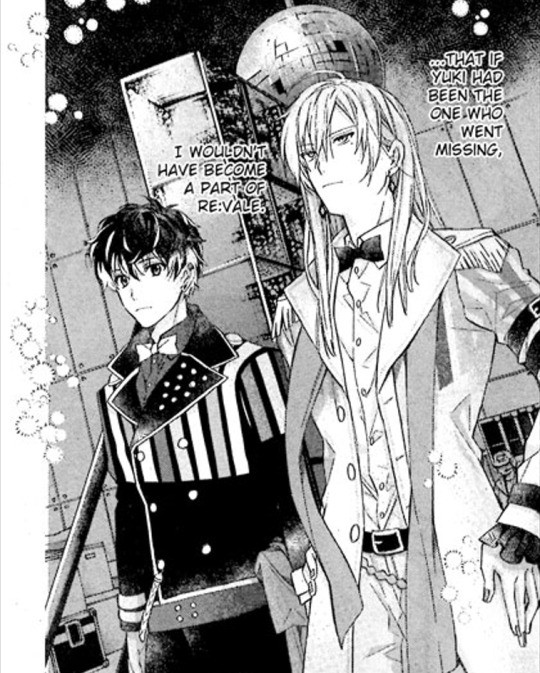
Momo confirmed: there can never be a Banri-centric three:vale
And actually, his logic behind this is really interesting. Because at it's heart, the difference is that with Banri, Momo could never have formed the same sort of codependent relationship that he does with Yuki. Banri is capable of taking charge and taking care of himself, and so Momo wouldn't feel the need to step forward and try to help him.
Hell, it's only after he realizes that no one's taking care of Yuki that he reaches out to him in the first place. Momo establishes very well in Re:member that he needs to feel needed and useful to feel loved, or to express his love, and Yuki lets him do that in spades. Banri, though. Banri doesn't need someone to dote on him (or at least so judges Momo) and therefore Momo's acts of service (his declarations of love) are unwarranted at best and unnoticed at worst.
Whether or not this is actually true is a whole separate question. Banri does seem to rely on Momo when he's helping them out backstage (Momo valiantly kills the dreaded spider for him) -- but he does it in a moderate sort of way, taking the time to make sure Momo's not overexerting himself (ie, when he's lugging around more equipment in one trip than he probably ought to be) and that he is generally taking care of himself as much as he's taking care of others.
But Momo seems to want someone who relies on him too heavily. He needs to devote himself fully and completely to another person (perhaps because he feels he can no longer fully devote himself to his own dreams, so he seeks some other outlet, someone else's dream to latch onto to replace that). He gets drawn in by Yuki's sopping wet meow meow nature and the fact that Yuki so clearly needs someone to take care of him, because Yuki is the only one who enables him to express his love in the way he wants to. Needs to, perhaps. Regardless of how (un)healthy that expression and the resulting relationship is.
That's why MomoBan won't work with just each other. That's why they need Yuki to draw them together: Momo needs someone who he can devote his everything to, and Banri can never be that person for him.
#I forgot he says this#I was looking for this panel earlier when I was gathering examples of their assigned sides but I forgot he just. says it openly like this#it is really interesting that we never really get to see Ban's impression of Momo tho#obviously everything we see of their early relationship in re:member is heavily colored by it being in Momo's POV#so we see Ban as Momo sees ban : cool. collected. suave and hunky. and most of all independent#bug killing aside -- which sort of teases the idea that maybe if it weren't for yuki Momo might be able to see more of how#Banri COULD fulfill that need for him to be useful to someone#but he's so besotted with Yuki (even before he realizes it)#(because despite his claims that he likes them both equally it's pretty clear here that he's already picked his favorite)#but he's so besotted with Yuki that Ban's needy moments don't even register to him#maybe if everything had been different#and Yuki had never been in the picture#the two of them could have meshed well together#But as it stands Yuki fulfills everything Momo wants in a partner - someone to devote himself fully. who always needs him and relies on him#someone who can give him purpose and direction -- not by guiding him but by needing guidance#man I really need to learn to not dump whole paragraphs of analysis in the tags huh#idolish7#i7#re:vale#yukito orikasa#momose sunohara#banri ogami
39 notes
·
View notes
Text
How popular is MadaSaku in context of other Madara’s and Sakura’s ships? Part 2
@madasakuweek
I am honestly shocked how many people liked my ship popularity analysis. Well, prepared for the second part - Fanfiction.net. It’s even longer!!! But imo more interesting.
Finding the popularity of ships on ff.net is both easier and more complicated, depending how do you approach the problem.
Let’s break up the task into two parts.
Approach 1
FF.net has a Pairing Option that was introduced in October 2013. This function makes the names of characters appear in square bracket, for example: [Madara U., Sakura H.] indicating that those characters form a romantic pair in a given fic.
When using Filters (Figure 1.a.) after choosing the character of interest, one can tick the Pairing Option, and then browse (using up and down arrows) through all the characters of the fandom. The number of fics tagged with Pairing Option between the character of interest (here: Madara) and every character B (here: Sakura) appear on the bottom of the panel (Figure 1.b.).
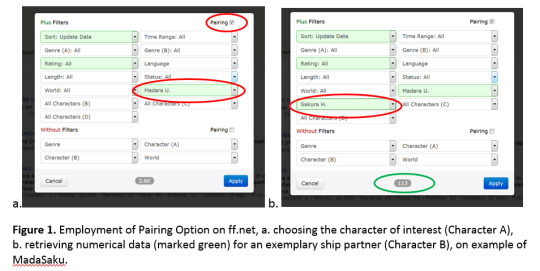
Data gathered through browsing through all of the Naruto characters with Pairing Option On give unequivocal results. The only limitations of this method is the relatively late introduction time point of Pairing Option (introduced in 2013, while Naruto started publishing in 1999), and sometimes peculiar definitions of “Characters” on ff.net (example: Naruko as a separate character, “Team 7” as a “Character”).
Results for Madara and Sakura are presented below (Figures 2. and 3.) For clarity, ships with four or more fics are shown for Madara. In case of Sakura, all the ships with >4 fics in a graph would blur the picture. Therefore, her Top 20 ships are presented in Figure 3., and the rest is summarized in the Table 1. The analysis was performed on 22.10.2019.
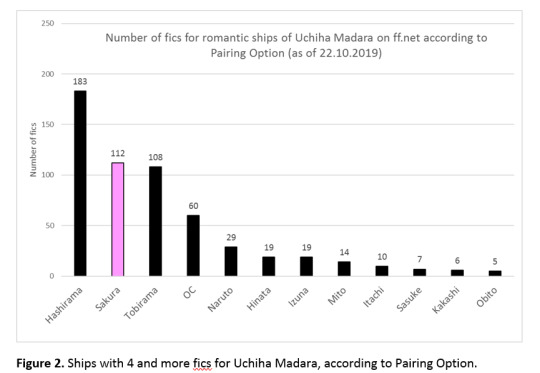


However, ff.net was launched on 15.10.1998 (which precedes publication of Naruto by one year) so there is a 14 year-worth of fic creation when the Pairing Option wasn’t available. To get the complete overview of ship popularity it is necessary to include the body of work created in the earlier years of ff.net.
This issue was addressed through Approach 2.
Approach 2
During the period of 1998-2013 fics were labelled with ship names in the summaries, and readers would look for ships of interest typing ship name into the search box. During those times certain conventional phrases were coined for the ships, and putting those in the summary allowed potential readers to find the story. Searching ff.net using selected phrases and collecting the corresponding fic numbers gives insight into those part of fanworks. Employment of search engine is shown in Figure 4. on the example of phrase “madasaku”.
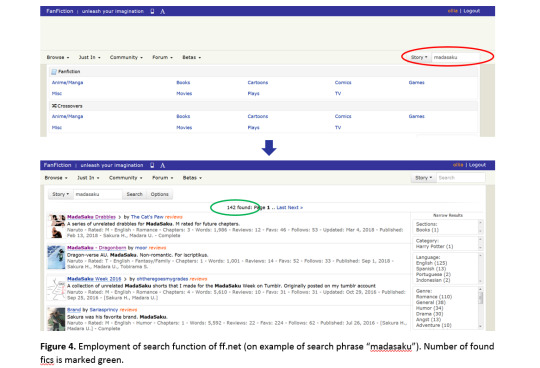
I performed searches for common ships, basing the list on the ships with 4 or more fics as found using Pairing Option (see: section above).
I searched for the phrases that were and still are still commonly used ship names in Naruto fandom.
In general, there are three common ways to indicate a ship:
a) Merger of names, usually using first two syllables of both names, usually (but not always) with male name being first part of the phrase. Example: madasaku, and (less commonly used) sakumada. For the M/M and F/F couples, both orders are used, and it is impossible to predict which form is more common. Example: sakuhina and hinasaku would be used with similar frequency.
In case of names composed of two syllables or shorter, one syllable is often used.
b) Name_1xName_2 – complete names of characters separated by letter “x”, without spaces in between. There is no strict preference as to which name goes first more frequently, i.e. sakuraxmadara is equally plausible as madaraxsakura.
c) A combination of the above, i.e. shortened versions of names connected with an “x”, without spaces (example: madaxsaku)
Search engine of ff.net is case-insensitive, i.e. searching for “madasaku” will bring the same results as searching for “Madasaku” and “MadaSaku” (thank gods).
Other possible naming convention, even if there are/were used, aren’t correctly recognized by the search engine of ff.net. If there are spaces between the words of the phrase (example: “Madara x Sakura”) the search results in all fics containing words “Madara”, “x” and “Sakura” in summary, but not necessary together. Separating character names with slash “/”, even without usage of spaces (example: “Madara/Sakura”) results in list of fic containing “Madara” and “Sakura”, not necessary together (slash symbol gets ignored).
Therefore, the ship names of the kinds described above weren’t included in this analysis.
Other potential ship names variations (using “*”, using “&”, and surely a multitude of others variants that I couldn’t think of) were not included due to their relative infrequency (and limits to capacity and imagination).
For every ship included in the results of Approach 1 (total 43 searches for Sakura’s ships, and 12 searches for Madara’s ships), I searched for the following phrases (on example of MadaSaku ship):
madasaku
sakumada
madaraxsakura
sakuraxmadara
madaxsaku
sakuxmada
Certain ship names don’t follow the usual rules and/ or required special treatment. For example, for the ship Gaara/Haruno Sakura the common names merger is GaaSaku (and not GaaraSaku). Tsunade/ Haruno Sakura is equally often (or rarely, because it is very rare) abbreviated to TsuSaku and Tsunasaku. Fics tagged with TobiSaku name merger may mean Senju Tobirama/Haruno Sakura as well as Tobi (Obito’s persona)/Haruno Sakura – in this case, fics were manually inspected, and assigned to correct categories. Ship with Naruko (which scored relatively high in Pairing Option analysis), was not really possible to assess, because the merger name “narusaku” is identical for the merger of Uzumaki Naruto/Haruno Sakura (for good reasons).
All the fics for given pair were summed up (i.e. for Uchiha Madara/Haruno Sakura ship the fic numbers retrieved through searches for “madasaku”, “sakumada”, “madaraxsakura”, “sakuraxmadara”, “madaxsaku” and “sakuxmada” were added together).
Results for Madara and Sakura are presented below (Figures 5. and 6.). In case of Sakura, including all the examined ships in a graph would blur the picture. Therefore, her Top 20 ships are presented in Figure 6., and the rest is summarized in the Table 2. The analysis was performed on 22.10.2019.

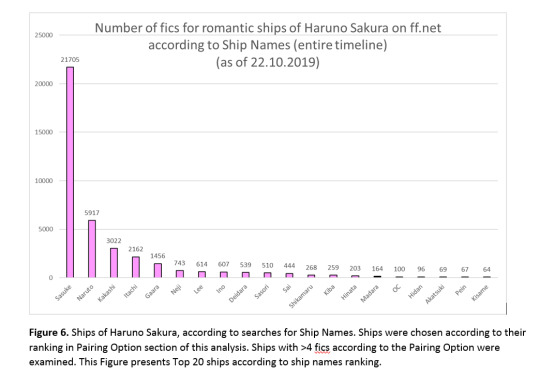

This list presented in Table 2 is not a comprehensive one. There are certainly more ships with <10 fics that were not included. One prominent, detected example is Chōji, who has 13 fics in as a ship partner of Sakura, but was not included in Table 2 because according to the Pairing Option he had no fics with Sakura.
Limitations of the method
Employed method depends on performing six independent searches and summing up the numbers from those searches. A fic tagged with more than one of the searched phrases will be counted multiple times. For example: if a fic contained phrases “MadaSaku” and “MadaraxSakura” in its summary, it was counted twice. In extreme case, one fic would generate six data points: one real, and five false.
Nevertheless, since the same treatment was applied to all the pairings, the errors should be distributed in the same way across all the ships. Therefore, even if the numerical values obtained through this analysis don’t necessarily correspond to reality, the results should reflect respective relations between the ships (i.e. “ranking” should be correct). This assumption is true however only if all the subdivisions of the fandom follow the same customs and tagging etiquette. I.e. if creators writing for SasuSaku followed a habit of including only one Ship Name in their summaries, while creators of MadaSaku tended to include multiple Ship Names, then my method of analysis would overestimate the significance of MadaSaku ship. However, I am not aware of such trends existing in Naruto fandom.
Additionally, Ship Name tagging system allows for tagging infinite number of ships in one fic, therefore certain fics have been counted multiple times.
Discussion
When considering fics tagged with Pairing Option, Sakura ranks as Madara’s second most popular ship partner, after Hashirama and before Tobirama. As on AO3, it is telling that a relatively “exotic” pairing with OC ranks 4th among Madara’s ships.
Madara is the 9th most popular ship partner of Sakura. Comparing and contrasting Sakura’s data between ff.net and AO3 would be an interesting analysis in its own right, but here I will only point out the switch of positions between Naruto and Kakashi as Sakura’s ship partners (Naruto is a strong 2nd on ff.net, while Kakashi takes this position on AO3); and relatively low, 7th place of Ino (strong 4th on AO3).
When taking into account data gathered though Ship Names Searches, Sakura ranks as Madara’s 2nd most popular ship partner (after Hashirama and before OC).
Madara, on the other hand is Sakura’s 15th most popular ship partner. Since Ship Names Searches results are mostly derived from fics published in earlier years in Naruto fandom, his lower place can be explained by his very late appearance in the franchise (on-panel in February 2008 - almost 9 years after Naruto started publishing and in person in the story in October 2011 - 12 years after begin of publishing).
Data gathered in this analysis present a unique opportunity for looking into the development of ship popularity over time.
Results from Pairing Option reflect mostly the state of fandom in years 2013-2019, while the results from Ship Names Search show the status from the earlier years. The exact division is however somewhat blurred as some fics published before October 2013 has been retroactively tagged using Pairing Option (even if the majority of older fics remain untagged). The reverse is also true – many fics published after introduction of Pairing Option, even as recently as end of 2019, fail to use it. Additionally, many fics are tagged using both systems: the Pairing Option and Ship Name in summary.
Nevertheless one can tentatively regard Pairing Option results as “new”, or “current” ones, while the ones coming from the Ship Names Searches as “older” ones.
Figure 7. presents position changes in Top 12 Madara’s ships. Ranking from Pairing Option analysis was regarded as current and compared to the “older” ranking composed from all the fics tagged with Ship Names (regardless their publishing date). A positive value in the Figure 7. indicates a gain of popularity, for example: Tobirama gained 2 positions among Madara’s ships when comparing the “current” and “older” results.
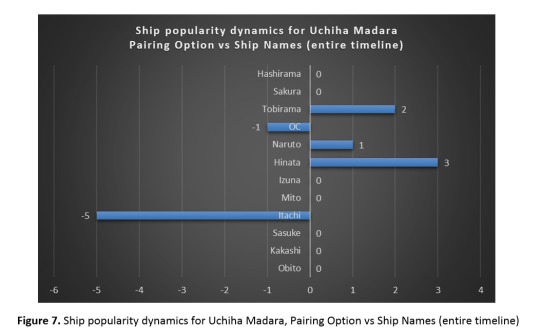
This analysis reveals that certain ships (with Tobirama, Naruto and Hinata) gained, while ships with OC and Itachi lost on popularity. Dramatic loss of Itachi ship popularity is very interesting and one can speculated that it could be caused by Tobi/Obito reveal.
The same analysis was performed for Sakura’s ships and is presented in Figure 8.

Inspecting changes in Sakura ships’ rankings allows for several interesting observations. Minato, Shisui, Madara and Sasori are among greatest winners. It is symptomatic that all, except Sasori, are characters that appeared (or became relevant) later during the franchise. Among the characters losing in popularity as Sakura’s ship partners are members of Konoha Eleven (Lee, Kiba, Sai, Neji), an Akatsuki member (Deidara) and OC. It should also be noted that five top positions (Sasuke, Naruto, Kakashi, Itachi and Gaara) remained unchanged.
To further examine the “current” and “older” state of fandom, upon harvesting Ship Names data I sorted the fics according to publication date and took note of how many fics were published before and how many after 01.10.2013 (approximate date of introduction of Pairing Option tool).
If one repeats the analysis from Figures 7. and 8. considering only fics published before 01.10.2013 as “older” ones, the following pictures appears (Figure 9. and 10.):
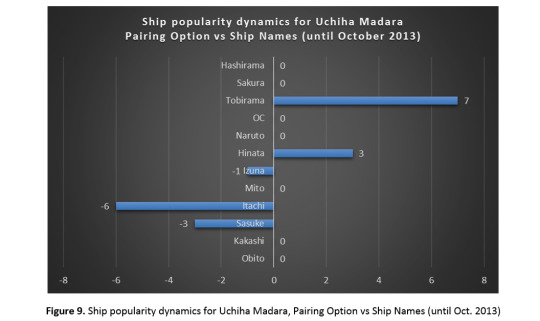
Using this definition of “older” fics (i.e. fics tagged with Ship Names that were published until October 2013), the gain of popularity of Tobirama ship becomes even mor evident (gain of 7 positions). Ships with Itachi (as in the previous analysis) and Sasuke (undetected in the previous analysis) lost on popularity.
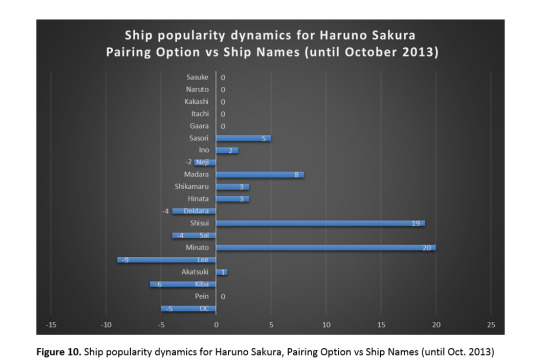
Sakura ships’ dynamics according to this definition of “older” fics show even more pronounced position gains of Minato and Shisui, but otherwise similar trends to previous analysis.
Analysis of ship popularity on ff.net is a challenging one, but since this platform was, and still is main archive for Naruto fandom (407 thousands fics vs 49 thousand on AO3) it is important to address this issue even if methodology is far from perfect.
I am open to all the comments, suggestions and hints, as the data collection was a major effort and I’m sure that this data can be used in many other different ways.
56 notes
·
View notes
Text
MUST-ASK SOFT SKILL QUESTIONS BEFORE HIRING NEW EMPLOYEES

Soft Skills Get Little Respect, But Will Make Or Break Your Career.
Peggy Klaus
Soft skills are essential! From recruitment to teamwork, collaboration, communication, and decision-making, soft skills remain an integral part of an employee’s journey throughout. Hence, helping new employees fit into the company culture appropriately and ensure maximum productivity.
Soft skills cannot get quantified. So, it becomes a little more challenging to go for a screening of these skills. And that is the reason employers must make sure to ask a few soft skills questions to recognize the employee’s understanding, thinking ability, persona, and motivation towards the job role specified.
There is nothing right or wrong in a soft skill-based question as it ultimately depends upon the individual answering them.
So, in this article, we have gathered some soft skills assessment questions with different categories to help you identify and hire the best candidates for your organization. Let’s get started.
COMMUNICATION-BASED QUESTIONS

The communication skills assessment helps evaluate the candidate’s ability and approach towards a particular task by implementing professional communication etiquette.
So, here is a list of communication soft skills questions that you must ask the candidates before recruiting them for your organization.
1. Tell me something about yourself. 2. How can you explain to a layman about the job role offered to you? 3. Explain the characteristics of this object and try selling this to the panel. 4. How would you handle the situation if you identify your colleague suppressing your achievements at the workplace? 5. What is your preferred mode of communication: Written or verbal? 6. Good listener or communication: What is your pick and why?
TEAMWORK RELATED QUESTIONS

The employees you will be recruiting will have to work in a team either remotely or at the workplace. Hence, it is necessary to evaluate and check if the candidates are willing to work in a team or believe in solo efforts to accomplish a task.
1. Do you think team events are necessary at the workplace? 2. What steps would you take to bring the entire team back on track if they are not remaining productive? 3. Imagine if a task gets assigned to your team. And all of the members carry a different approach towards resolving the issue. How do you make all of them work together? 4. How can you define team spirit? 5. How would you motivate your team members to put their 100% effort into accomplishing their tasks on time?
LEADERSHIP QUALITY EVALUATION QUESTIONS

Excellent leaders bring out the best in the people around them!
So, with the following questions, you can check if the candidate possesses the characteristics of a good leader who can take his team along and achieve the set goals.
1. What would you do if you find out your manager is making a mistake? 2. If you find a pattern of your team members quitting the project one by one. What would be your take on this? 3. How do you divide the workload within a team? 4. What are your expectations from your manager? 5. If your organization is undergoing financial problems, how would you decide on the list of employees to fire?
FLEXIBILITY CHECK ASSESSMENT

The workplace flexibility test helps you count on the candidates who can adapt to any changing location or need without any difficulty. The one who scores good points on this test is more likely to get comfortable in demanding situations and work efficiently.
1. Do you find adapting to new changes difficult? Does it affect your productivity and efficiency? 2. If there is any surprise task assigned to you, would you take it positively or find it challenging? 3. Are you comfortable rearranging your schedule? 4. Can you deal with short-notice and urgent tasks? 5. Do you like working in a routine?
PROBLEM SOLVING ASSESSMENT QUESTIONS

Choosing a candidate who is good at problem-solving can prove to be a hit for your organization. An efficient problem-solver has a well-organized and reasonable approach towards any raised issue. Hence, by taking this assessment, you can know about the modern approaches of an aspirant for solving a problem.
1. What are some common attributes for successfully solving a problem? 2. Specify the time when you used to have to be creative or productive in resolving a problem? 3. What is the right time to analyze information for addressing a problem successfully? 4. Do you have a time when you identified a problem and resolved it at the earliest? 5. Label the time when you ought to resolve a problem in an emergency?
CREATIVITY-BASED QUESTIONS

The creativity assessment is for understanding the abilities of a candidate to approach an assignment creatively. It tests the mental capacity of an aspirant who can stand out from others.
1. What do you label the book if it describes your life? 2. How will you express your views at meetings to fuel your creativity? 3. State an example of a business being inventive and creative to become successful? 4. How can you encourage creativity and innovation at your workplace?
INTERPERSONAL SKILLS ASSESSMENT

Interpersonal skills can help you understand the capability of a candidate to maintain successful relationships with their coworkers. With this assessment, you can recognize if the candidate can socialize with others comfortably or not.
1. State some of the key elements to build a healthy relationship with your coworkers? 2. How to handle a conflict with a coworker? 3. How do you deliver unpopular information? 4. Do you ever face a situation when you organized a healthy relationship with someone you didn’t like earlier?
TIME MANAGEMENT CHECK QUESTIONS

With the time management, soft skills test, you can check if the candidate can make the best use of the office hours and remains productive throughout.
Not just in the traditional workplace, the employees have to be productive while working remotely as well. Hence, this assessment can check if the candidate has a well-defined approach to plan, prioritize and execute their thoughts on the projects assigned.
1. How well do you multitask? 2. What is the one that describes you: ‘done is better than perfect or ‘everything has to look perfect? 3. How do you prioritize conflicting deadlines? 4. What will be your approach when you struggle to meet a deadline? What will you do? 5. If you get assigned with something big right immediately to the end of your day. What would be your reply?
DECISION MAKING ABILITY TEST

Decision-making ability can check if the candidate possesses the characteristics of a good leader. It includes making the right decision in the right situations to make everything fall into place and let the work operate smoothly.
1. How do you deal with it, when you have to decide something under pressure? 2. Would you like to take the power of decision-making and responsibility, or would you prefer to hand it over to someone else? 3. What is the most difficult decision you have had to make on the job? 4. How to deal with the wrong decision you have made by mistake? 5. What are the most challenging decisions to make?
EMPMONITOR- THE BEST EMPLOYEE MONITORING SOFTWARE

Now that you have the best set of questions to evaluate the candidate’s soft skills, we are sure you can find the perfect match for your organization who are productive, efficient, and have a positive approach towards their job.
Also, when you have such potential employees, the entire workplace has a competitive vibe as every employee will wish to stand out.
But how can you pick out the best from them? How do you analyze who has a good command over their soft skills and can manage an entire team in a better way?
Well, for that, you will need an employee monitoring software that provides you with every detail of your employee activity. And the best employee management tool with all the extraordinary features and an intuitive dashboard is EmpMonitor.
EmpMonitor is a reliable employee monitoring, managing, and tracking software that works wonderfully in the stealth mode, behind the computer screens of the employee’s workstation, and provides a detailed report of all the activities performed by the employee throughout the working hours.
Productivity Report: EmpMonitor shares a detailed productivity report. Here you can check the productive and unproductive activities of an employee throughout office hours. So, if you find any employee remaining unproductive for a certain period, you can take the necessary actions.

Screenshot Monitoring: The tool captures screenshots at random intervals and shares a report. Here you can find the screenshot of the employee’s screen during the working hours and check on which task they were working.

Website And Application Usage Monitoring: It also shares the insights of the website and applications visited or used by the employee while working. Hence, you can also mark the sites as productive and unproductive and keep a check on your employees.

Keystroke Logging: The keystroke logging feature of EmpMonitor is pretty interesting. You can get your hands on all the details about the keypunches of your employee’s workstation.

Attendance Monitoring: You do not require an attendance monitoring tool separately if you have EmpMonitor. It accurately marks the clock in and clocks out the time of the employees.

Cloud-Based Storage: EmpMonitor has cloud-based storage and keeps the data safe for about 180 days.

Apart from all these, EmpMonitor has a flexible and reasonable pricing plan. And the fun part is it also offers a 15-days free trial. So, grab your free trial session now, and do not miss out on this opportunity.
Check Out Our Latest Posts:
Workplace Harassment: Types And Recognition The Best Practices To Set Productivity Benchmarks For Your Company New To The Corporate World? Learn These Imperative Approaches To Behave Rightly
OVER TO YOU
Screening candidates based on both soft skills and technical skills go hand in hand. Though there is no correct answer to a soft skill question, adding a few of the above-mentioned questions can help you analyze the best fit for your organization.
I hope the article helped you know more about soft skills. Is there something that we can incorporate? Please drop your thoughts in the comments below. I would love to hear from you!

Originally Published On: EmpMonitor
#Employee Monitoring#Employee Management#Employee Productivity#Employee Monitoring Software#Soft Skill
0 notes
Video
youtube

cheap essay service
About me
All Courses Assignments Solutions For Everyone
All Courses Assignments Solutions For Everyone Do you could have any difficulties guessing how precisely the completed assignment should look? We are glad to assist you with any specifications. The writer instantly will get began on researching and gathering all the relative information wanted. They use the internet, books, newspapers, articles as well as many different reliable sources of data. This is an integral a part of the project and the level of analysis reflects the hassle you’ve put into the assignment. These are some valid considerations that have to be addressed earlier than they proceed and place an order for an task even if it's a pro essay service provider. These essays are imagined to convince the reader to agree with the writer’s perspective. Students are introduced to essays in elementary college and slowly over high school their writing and understanding expertise are constructed up and polished. At university degree, essays are in depth pieces of data that require consideration to element. We completely understand if your thoughts is revolving round skepticism on hiring an educational service online and handing over your assignments and tutorial work to that web site. Sure, it can be tough trusting somebody you have by no means met and in contrast to the movies, you actually need to be careful before you enter into a long run companionship with them. that produce a hundred% plagiarism free essays tailored to fulfill your custom necessities. Then, make a plan and come up with a kind of 'script' on your work. When writing a tough draft, strive mentioning each and every idea you have give you. All mentioned before allows us to help your ‘write my analysis paper please’ request. Your task would look as when you spent an enormous amount of time on analysis, title development, writing, processing, and sprucing it to perfection. Whatever the argument, the reader ought to agree with the writer’s views. The writer can use supporting arguments however the case must be constructed on facts and logic. The writer must also current either side of the story to keep the reader informed and never make them agree by misinforming them. Writing an essay is something that college students are familiarized with at a very younger age. Our content material is all the time written from scratch and is specific to the client’s needs and calls for. This is the initially step in doing the essay. As quickly as the order and the mandatory particulars are confirmed, a writer is assigned to the project. This benefit goes with all the opposite options you get for the value. Please notice that the variety of revisions is proscribed if you have any extra instructions or sample to follow. However, you could have a chance to contact your author or assist group by way of phone or chat at any time. If you don’t have access to a sure guide, our database would possibly store it. It is our immense knowledge in a analysis paper business which enables us to give you useful advice each time! Besides, earlier than sending the completed order again to you, our dedicated specialists will proofread the paper and make all the required corrections. As you possibly can notice from the examples on our website, even essentially the most complex papers are excellent. In addition, we've particular plagiarism checker tools. We ship superior high quality essays throughout the given deadline together with limitless revisions. The panel of skilled and enlightened writers working at EazyResearch possess the abilities to tackle all your homework-related worries, so you can sit back and loosen up. Don’t let prolonged dissertations get one of the best of you! The writers at EazyResearch produce flawless content overlaying an extensively big range of topics for any subject you wish to get dissertation writing accomplished for. Later, you'll be able to add citations, enhance the wording and make other modifications if necessary. Keep in thoughts that arising with a top quality paper means making use of the things you are already conscious of. This was the most effective write-up I obtained by the skilled writers from here. Our writers assure the usage of utterly genuine and dependable sources while providing completely original content. There is zero material that's copied from different articles, websites or anywhere else.
0 notes
Link
Step One – Start with a blank page
Squarespace 7.1 has a more streamlined setup process for styling your site and adding content. There is no need to start with a specific template. If you are wondering if your website is on Squarespace 7.0 or 7.1 – simply identify where the demo expansion arrow is. Left is Squarespace 7.0, right is Squarespace 7.1:
Squarespace 7.1 demo arrow is on the right

When logged in, using the main Squarespace left navigation, head to Pages → Main Navigation, then click the + icon. When prompted select the Blank Page option out the Pages options:
Select a blank Squarespace page

For better context in the tutorial we are putting together a website for a New Orleans dog walking side hustle by (an ambitious but fictitious) Sarah Young. After you’ve added your new page, name it accordingly. I’m simply naming mine Sarah Young as I’m planning to make this the only page on my site. Squarespace 7.1 has a new Edit button shown here:
Squarespace edit page button

Once clicked, the page editor opens up.
Step Two – Add page sections
Now your blank page should have a standard header and footer, with a big empty area in the middle. This is where we are going to add our page sections. Squarespace 7.1 boasts beautifully pre-built page sections to create layouts with text, images and galleries – saving us a ton of time:
Squarespace 7.1 page sections preview

Let’s take a step back for a second to consider what content we are going to need in our Landing Page to convince potential clients to hire Sarah. These are the questions they could possibly have and the content needed to answer:
Who is this person? – Introduction/About
How much do they charge? – Rates
Can we trust them? – Testimonials
How can we get hold of them? – Contact Form
And that’s it, those are our 4 Landing Page sections. Let’s add our first section by clicking the Add Page Content button:

This kicks off the page sections pop-up. For the introduction/about section I really like the look of this overlapping design:
Adding a headline page section

Just click the item to insert the design. If you would like to get more detail on the content editing and styling, I’d strongly recommend watching the embedded video above. Simply put, each element is editable inline. Meaning you hover over elements and select the edit icons. Then continue to go through the options available. In the Content tab (shown here) you can change the background image. In the next Design tab you can change the alignments and the button text + link (I’m going to show you how to link to the various sections within the long-scrolling page at the end of this tutorial).
Content inline editing

After some quick edits and uploading the pic of Sarah, our intro looks like this:
Sarah Young Landing Page - introduction content block

Next is the Rates section. Add another section by clicking the blue + icon below the section we just added. In the Text sections, I quite like this minimal layout which could have the price to the left:
Adding a text page section

This Rates section feels quite bare with the white background, so we can change the aesthetic using the color scheme options to the right:
Changing section design aesthetic

A few minor content edits along with the Accent Dark color scheme option really did the trick:
Sarah Young Landing Page - rates content block

Next up is Testimonials. Within the Quote page section options I like this layout with 4 clear testimonials in 2 columns:
Adding a quote page section

Considering how often people skim website content, it is good practice to highlight the main takeaway using bold text. Another tip is including the location of the New Orleans clients (next to their name) – adding local authenticity to the Landing Page:
Sarah Young Landing Page - testimonials content block

Finishing up Sarah’s Landing Page is the footer contact form. Out the Contact page section options, I like the first option with the form to the right:
Adding a contact page section

Just like the Rates section above, I think the white background is a bit bland, so I’m going to change it to the Accent Dark color scheme:
Sarah Young Landing Page - contact content block

Having alternate color sections also divides up the page content a bit better for the visitor. That’s it for the Landing Page content! Let’s take a step back and have a look at the Landing Page:

Step Three – Fix the header position
Ideally we’d like the header navigation to remain fixed while the visitor scrolls. This allows the visitor to easily navigate between page sections at any time. To kick off the header options, hover over the header area and hit the big Edit Site Header button. This opens up an option panel to the right. This panel is where you would upload your logo if needed but I’m happy with the default, plain-text “Sarah Young” for this Landing Page. Within the header option list, open up the Style options. Now enable the Fixed Position option:
Enabling a Fixed Position header navigation

Step Four – Add header links to page section
We want the user to click a website header link and be transported to the relative section. Example: clicking the Testimonials header link, scrolls the user to the Testimonials section within the Landing Page. To begin, the need to remove the default header links set by Squarespace. Simply drag those links out of the Main Navigation area and into the Not Linked area:

Then we need to add custom links to the Main Navigation area. In this use-case I’m adding links to Rates and Testimonials. Click the Main Navigation + icon then select the Link option at the bottom. For the Rates link, enter in the Link Title Rates and under the Link URL setting, enter in #rates like this:
Adding custom links to header navigation

Repeat for Testimonials, ensuring #testimonials is the link URL. Same will go for the Contact button. Head back to the header options from earlier but steer to the Elements option. Set the button link to #contact like this:
Adding custom links to header buttons

Lastly, the same applies for the Read Testimonials button featured in the intro section. Click the edit icon, switch to the Design tab and set the URL to #testimonials like this:
Adding custom links to buttons

Step Five – Add section Anchor links
Think of anchors as positions within our long-scrolling webpage. Anchors are assigned a name like ‘projects’. We can navigation to these anchor positions by linking to the anchor name with a hashtag (#) prefix. Example #projects To add an anchor link, we need to add a tiny bit of custom code above the relevant section, it’s real easy. When editing the page, hover your tear drop cursor above the section to kick off the content block option panel. Select the Code block and proceed to enter in an anchor link matching the links set in the previous step. Example:
Adding anchor links using a custom code content block

Simply repeat for the Rates section: <a name="rates"></a> and the Contact section: <a name="contact"></a> Once completed your website header links (set in Step Four) should now change your Landing Page position when clicked.
Bonus Tip Six – Adding smooth scroll
To enable that graceful smooth scroll motion when clicking links, head over to Design → Custom CSS in the main Squarespace menu and paste in the following code: html { scroll-behavior: smooth; } … and that’s it! Our long-scrolling Landing Page now features a fixed header navigation that smooth scrolls to the relevant sections:

FAQ: What are the benefits of using Squarespace?
Squarespace is a leading online website builder. What sets them apart from the rest is their superior level of design and customer support. They have a huge support team and are available 24/7. Other main benefits are:
No Website Hosting Needed - their platform is fast and secure
Online Content Management - all edits are done within your browser, no software needed
Easily Drag and Drop Images - unlimited galleries with unlimited bandwidth
Free Domain Name - when registering for your first website, if you pay annually (renews at standard rate)
Beautifully Responsive - all templates work for all devices, so you only have to design your website once. Test and preview how your website will appear on a range of screen sizes.
Blog Sections - can easily be added to start sharing your journey
Commerce Solutions - are an upgrade away if you want to start selling products
Email Marketing - gather email addresses, send marketing emails and analyze the reader email activity
0 notes
Text
Castle Point Anime Convention Wrap-Up!

Castle Point Anime Convention is in the books! It surely indeed was one for the books as well, coming from someone who has not attended Castle Point in literal years. Try...2012 to be exact. Seven years passes by so flipping fast. To think, the last time I was at this convention was back when I was a mere nineteen year old! Regardless, time flies and as we get older and we evolve, so too must our conventions that we attend. If conventions do not improve of evolve, then they will never last for the long term. Rather dire things to say for an opening to a wrap-up post, but it’s how I personally feel on the matter. It’s a challenge for grassroots conventions to pull it off, but for those who do, the payoffs are grand. In Castle Point’s case, they have pulled it off. They have evolved greatly from the small yet modest “college con” that I recall attending way back when.

KDA Akali by projectxayah and KDA Evelynn by melanubis
As such, to end this foreword, I’ll be making some comparisons to the last time I attended CPAC back in 2012, to now, throughout this article. It’s going to be quite a lengthy read, so strap in everyone!
The Meadowlands Expo venue was simple to arrive with no issues on our end. A simple fifteen-minute-at-best-half-hour-at-worse-due-to-traffic bus ride from Port Authority was all that was needed to arrive. The bus stop even lets you off directly in front of the convention center itself! Here is where I can immediately talk about how helpful the staff was towards myself and the rest of the podcast. When we needed help as far as knowing where to go and con assistance in general, everyone was able to help, but, there weren’t any crowding that I noticed as well. Lines were handled well, and the Dealer’s Room/Artist Alley, places where there’s known to be a packed pandemonium, was handled well. Mainly this was due in part to there being a designated entrance and a designated exit. Take notes future cons!
youtube
As the time drew nearer for the gates to be open, the hall slowly but surely filled itself with various cosplayers, attendees wearing gaming and anime inspired apparel, and soon enough the events began.
One of the first events was a maid performance, made to kick off the opening of the anime convention. It certainly had set the tone for the convention for sure, where one could hear it in ambiance even if they weren’t there to physically attend.
After the opening ceremonies concluded, I was left to explore the event as it were. One of the first stops I take in any convention is within the game room, so to speak. Majority of the games featured, due in part from the Snow Phoenix team, in the game room below are games in which I have played at least once, play on a regular at the local arcade, or games in which I never had played before (Or ever will play outside of cons)
Regardless of which category the games fell under, it’s always fun to go back to these games from time to time. Free play is just a bonus in all honesty. My personal favorite of the games featured here had to have been Sound Voltex, always a fine game in my book. The second being Crossbeats, a touch based rhythm game which, sadly, development ceased as of last year. It’s still a great game to go back to from time to time.
youtube
Another portion of the game room were console setups. These had a slew of fighting games ranging from the Street Fighter Collection to Mortal Kombat 11, Soul Calibur 6 to Tekken 7, and of course an entire section of CRT televisions dedicated to Melee. Tournaments were held throughout the weekend, which, unfortunately I didn’t make it as far as I would have liked. However, those who I had met were friendly enough to me.
Back on the topic of rhythm games, I had attended a rhythm game panel that was being presented later on that afternoon. The convention was split into two venues. The main venue, at the Meadowlands Expo, had the main events while the Holiday Inn had the extra panels. This was where the Rhythm Game panel was held.
Held by RhythmCore Gaming, the rhythm game panel spoke about the history of rhythm games, mainly focusing on Bemani games, as well as touching upon mobile rhythm games briefly as well. For those reading who aren’t aware of what a “Bemani” is, essentially it’s the rhythm game division of Konami. Familiar titles include Dance Dance Revolution, Beatmania IIDX, Sound Voltex, Pop’n Music, and so much more.

All in all, as far as presentation, it was a well run panel. From a technical standpoint, the Castle Point staff made sure all equipment that were in use were running well, as far as projectors for example. Crowd control was also handled quite well, to avoid overflow. From the panelist’s standpoint, I feel they had gotten the gist of what each game is and how they play. Being slightly critical, I feel some of those who were assigned to talk about a specific game went more in depth with their game than others, but I know more than anyone the challenge of running a rhythm game panel.
See, way back in 2013, I, too, ran a rhythm game panel at a convention that has long since been discontinued. A good friend of mine and I both ran the panel, yet, with technical difficulties due to the inability of the staff to assist us, as well as not informing the panel ahead of us that we were running late due to the technical difficulties, the experience gave me more of a headache than I’d like to admit.

An awesome ass couple cosplay that, sadly, did not have any social media :( I still dug it!
However, this is where I can once again praise the Castle Point staff for being on top of making sure the panel ran smoothly. I can also give respect to the RhythmCore Gaming group for tackling on a subject to appeal to a crowd that may look at an arcade rhythm game in fear and confusion. I suppose I admit I attended this panel to see how others would tackle such a topic. I give the panel a “Certified Nay’s Thumb Up.”
For the rest of the convention, I had made sure to try to get my fill in of taking pictures of as many cosplayers as I found whom caught my eye, all of whom you’ll see throughout this post. One in particular who caught my eye was a Kasumi cosplayer.

Kasumi from Persona 5 Royale by ZodiacKind
See, again, for the reader who may not know this about me. I am a huge Persona fan. When I had heard news that Persona 5 Royale was a thing and I had saw the trailer earlier that same week, I was hoping that the cosplay community would work fast.
The cosplay community would not disappoint me.
This cosplayer deserves special mention just for having this at the ready so quickly, so, for that I appreciate this so much!
Another cosplayer who I felt deserved an honorable mention was a woman who was a very good Sub-Zero, but also earlier that weekend she was Kratos. I had the chance to interview her as Sub-Zero in which the video can be found below.

Sub-Zero by Amarys Berry
I mentioned in my previous post about Winter Brawl that vendors are the underappreciated glue that holds a regional/major together. There will be a post separate from this one where I interview one of the vendors from Artist Alley, but the same sentiment is stated here. There are so many vendors in the Artist Alley with their own story and own purpose for doing what they love.
I, in fact, covered an Artist Alley vendor at the Con itself! However, I feel a paragraph alone won’t be enough to give them justice, so please be sure to read the companion article here where I discuss meeting with Bunnies & Cream! You don’t want to miss it, for sure!
In any case, the same could be said for cosplayers. Cosplayers are not so much the glue, but the exoskeleton that makes the entire convention worth it. Each cosplayer has their own story in terms of what got them into it, how long they’ve been doing it, and what made them cosplay certain characters.
Unfortunately, things can tend to go awry when you least expect it. The blade on your sword prop may hang loose, an annoying thread may linger on one’s dress, a shirt may be ripping from the seams. All of these nightmares are easily avoided by those on standby who are dedicated to make any mess a fixable one!
This was quite possibly one of the few points of interest that I saw at the convention. An “all in one” emergency repair station not unlike one you would see at a convention. I couldn’t help myself. I had to learn more. Thankfully these guys were friendly enough to answer my questions I’ve had. Big thanks!
youtube
youtube
With all of the maintenance that goes into making the perfect, subjectively of course, cosplay, no matter if it’s been a decade or ten days, every cosplayer is equally important to the well-being of any convention.
Even moreso when cosplayers engage in violent carnage within the squared circle and go for a swinging neck cutter as a finishing move.

In what was perhaps the highlight of the convention, the Cosplay Pro Wrestling event was a fitting end to an action packed weekend. Although I had caught it while in the middle of the event, what surprised me the most was how there was an actual story arc.
From what I was able to gather, the main story arc revolved around the face, or hero, Big Boss, feuding with Team Rocket, who formed an allegiance with Princess Peach. The main event was scheduled for Big Boss vs Princess Peach for the title.
Throughout the set, one of the matches I did see in its fullest was Winter Soldier versus, and I quote, “Jeff Harley Quinn.”
As you could expect from the name alone, this Harley Quinn shared a lot of Jeff Hardy’s likeliness as far as his mannerisms and his moveset. What one may not have expected, was Winter Soldier, who bore resemblance and a moveset similar to Roman Reigns.
Spears, Twists of Fates, Leg Drops, and Swanton Bombs were present here as one would expect to see from fans of both wrestlers, yet they also brought about some of Quinn’s cunning which was what gave her the overall victory.

Harley Quinn by Catie V
Eventually, after a match of Link vs Liu Kang, the main event transpired. Paing homage to heel stables of the Attitude Era, trickery was used while Team Rocket was able to give enough damage to Big Boss to have Princess Peach secure the pin.
However, when all hope seemed lost... Mario and Luigi, decked out in “Bullet Bill Club” shirts, went out and chased Team Rocket as well as Princess Peach out of the ring. What followed after was a tag team match, with more story building now that the Bullet Bill Club entered the scene.
youtube
There was so much more that could be said as to what transpired in this two hour finale to an otherwise action packed weekend, including one of the guys from Attack on Titan fighting Isabelle from Animal Crossing, but it was one of those events where you had to be there to experience it.
That’s the one thing I can say about the convention. For a two-day con, there was always something to experience. If you wanted to meet one of your favorite voice actresses like I had, you could do so.

If you wanted to take in the sights and experience panels and learn new things about otaku culture and the like, you could do so as well. There’s literally no right or wrong way to attend the convention and the only thing that I can recommend is to do everything you possibly can. Unfortunately some conventions don’t have that, but, with this year’s Castle Point I can definitely say that the community as well as the staff had pulled out all the stops to make it memorable.
With that said in conclusion, for this being my first anime convention of the year, it was a fantastic way to start. Thank you once again to the Castle Point staff for giving myself and my fellow members of the Geeks podcast for giving us the opportunity. I’ll definitely try to attend next year for sure.
As always, may the Lost Summer never end! Tune to us soon for the next post!
1 note
·
View note
Text
Securities Litigation Reform: Addressing the Class Action Lottery
When Congress enacted the PSLRA in 1995, one of the goals was to try to deter frivolous litigation. As time has passed, it has also become clear that many of the PSLRA’s procedural reforms also created a structure of incentives for plaintiffs’ lawyers. For example, the PSLRA’s most adequate plaintiff requirement created an incentive for plaintiffs’ lawyers to seek to represent institutional investors. However, according to a recent academic study, with the passage of time, some of the incentives have had a distorted impact, as the incentives motivate plaintiffs’ lawyers to try to get hold of a mega-case “lottery ticket” that will produce a jackpot outcome – for the lawyers. These distortions in turn are creating many of the ills we are now seeing the securities class action litigation arena, justifying, according to the academic authors, another round of securities litigation reform.
The February 2019 paper, written by Stephen Choi of New York University Law School, Jessica Erickson of University of Richmond Law School, and Adam Pritchard of the University of Michigan Law School, entitled “Risk and Reward: The Securities Class Action Fraud Class Action Lottery,” can be found here. The paper was released by the U.S. Chamber Institute for Legal Reform in connection with its February 26, 2019 event focused on securities class action reform at the National Press Club in Washington, D.C. Professor Pritchard discussed the paper on a panel at the Institute event. I discussed a companion paper released in connection with the event and written by Andrew Pincus of the Mayer Brown law firm in an earlier post, here.
In order to review the PSLRA’s impact, the authors collected data on every securities class action lawsuit between 2005 and 2016 that involved a disclosure claim. The authors also gathered information on the specific allegations raised; the efforts to select the lead plaintiff; and the case outcomes.
The authors begin their analysis by considering the frivolous cases that the PSLRA sought to discourage. They noted that these low-value cases continued to be filed in significant numbers, adding that “the evidence is unclear on whether [the PSLRA] effectively screened out frivolous cases.”
While the PSLRA was focused on addressing frivolous cases, it was “largely silent with respect to another category of cases: high-value cases.” The legislation was “not aimed at perceived problem with these suits.” And these kinds of suits have continued to be filed. Indeed, because of the possibilities in these kinds of cases for a jackpot payout, the system creates incentives for these kinds of cases to be filed. Indeed, in high-value cases, “there will frequently be a scramble of investors competing to serve as lead plaintiff,” for the simple reason that the plaintiff’s counsel that is selected as lead plaintiff likely will be awarded with hefty fees. Often these fees are awarded with little or no court supervision. These “home run fee awards” undermine the PSRLA’s deterrence goals “by skewing litigation incentives for plaintiffs’ attorneys, creating an incentive for law firms to pursue a wider array of cases in the hopes of hitting the fees jackpot if the case settles.”
To substantiate these findings, the authors first divide the case outcomes in the cases in their database into deciles, reflecting the range for the smallest to the largest recoveries. This analysis (reflected graphically in the article) shows that the most of decile groupings, the recoveries are modest, while the recoveries in the tenth decile are staggering. This analysis shows that “a small number of outliers have outsized importance” in the plaintiffs’ lawyers aggregate recoveries in these kinds of cases. As a result, the plaintiffs’ lawyers have a “disproportionate incentive to obtain the lead counsel position in the mega-actions.”
The authors then ask whether the merits of these mega-cases warrant the eye-popping settlements (and plaintiffs’ lawyers’ fee recoveries). The authors identified four types of allegations they say represent objective indicia of fraud. The four allegations are: financial restatements; SEC investigations; other government investigations; and termination of top officers. The authors then looked at the frequency of these types of allegations across the decile division of case outcomes.
The authors found that by assigning each case a “composite score” reflecting the incidence of these kinds of allegations, they were able to score the case outcomes by settlement decile. The authors found that the cases producing the largest settlements also have the highest incidence of objective factors related to fraud. The authors called this a “good news/bad news” message. The good news is that “the merits seem to matter in determining settlement amounts.” The bad news is that in these more serious cases, the plaintiffs’ lawyers “do little to uncover the objective fraud factors” as the existence of these factors is publicly disclosed. The plaintiffs’ lawyers, according to the authors, are merely “piggy-backing” on the problem already known to investors and to regulators.
Because the biggest lawyer paydays are in the biggest cases, the plaintiffs’ lawyers have incentives to try to file these kinds of cases. When the authors arranged the cases into deciles according to market capitalization of the company sued (as opposed to organizing the cases by the size of any eventual settlement), they found, ironically, that they cases against the largest companies are the likeliest to be dismissed. The authors said that the because of the “higher stakes, and thus the prospect of a bigger eventual settlement,” plaintiffs are motivated “to file suits in cases with less substantial evidence of fraud.” The high dismissal rate for suits against the largest companies “is driven by the lure of the mega-settlement, the lottery ticket of securities fraud class actions.”
The authors then turned to the lawyers’ fee awards in settled cases. Again looking at the cases by market cap decile, the authors found that the fees awarded increased for the settlements in the largest deciles, but the fees awarded as a percentage of the settlement amount decreased as the size of the settlements increased. While the fees awarded a as a percentage of the settlement decreased for the largest cases, the fees awarded in absolute dollar amounts were enormous. In reviewing the fee petitions by settlement size decile, the authors found that the plaintiffs’ hours worked, and even more significantly, the hourly rates claimed, skewed upward dramatically for the largest cases. These cases generated more work and higher fees “despite the evidence that the mega-cases tend to have stronger objective indicia of fraud” and the fact that “stronger evidence of fraud at the outset means that lawyer skill and effort play less of a role in generating a settlement.”
What the authors found is “a strong pattern of judges rewarding class action lawyers for the size of the settlement,” even though “the variation in settlement amounts is driven in large part by differences in market capitalization.” The plaintiffs’ lawyers in effect are “reaping huge paydays for suing the biggest companies.”
In turning to thinking about possible reforms based on these findings, the authors note that the appointment as lead counsel in the largest cases is “akin to receiving a winning lottery ticket,” because these cases will almost certainly result in a large settlement and a large fee award. The plaintiffs’ attorneys reap these awards even though “the risks in the most lucrative mega-cases are not that great.” The system, according to the authors may “overcompensate plaintiffs’ attorneys in securities class actions with the largest settlements.” The lottery aspect of these settlements “skews the selection of cases toward larger companies and away from the most egregious fraud.” The plaintiffs’ lawyers also have incentives to “direct significant amounts of time to attracting institutional clients.”
The authors suggest reforms that are calculated to try to alter these incentives. Their first suggestion is to reform the way fees are awarded. The authors note that in practice judges tend to “rubber stamp” plaintiffs’ attorneys’ fee requests. Recent revelations, the authors suggest, there could be significant value in incorporating greater oversight into this process. In the recent case involving the settlement of a consumer class claim against State Street Bank & Trust, an investigation of the plaintiffs’ fees found a number of problems, including the fact that the plaintiffs’ counsel had double counted the hours of several attorneys. The investigation also found that a large part of the fee award was paid to another attorney who had referred the institutional investor claimant to the lead plaintiff firm but had not actually done any work on the case.
The authors suggest that “to curb these practices, judges should scrutinize fee requests far more carefully,” or perhaps refer them to magistrates or special masters. The judges, the authors suggest, should also “probe the marginal contributions of the attorneys and the risk of non-settlement the attorneys face.” The authors suggest that Congress can also help curb exorbitant fee requests by setting presumptive limits on fees in the largest cases; for example, Congress might specify that in settlements over $100 million, the presumptive limit on fees should be limited to 10 to 15 percent of the settlement award and adjusted upward if the court finds there was extraordinary effort by lead counsel.
The authors further suggest that Congress should take a look at the lead counsel process, noting that “the profits of plaintiffs’ law firms depends less on the firms’ skill and hard work and more on their ability to amass a stable of institutional investors as clients.” The pressure to establish these kinds of relationships has led to questionable practices, such as the payment of fees to other attorneys simply for referring a potentially lucrative institutional investor plaintiff relationship without connection to any other actual services performed. The authors suggest Congress should amend the PSLRA to prohibit lead counsel from sharing its fee with law firms that do not actual do legal work. The authors suggest that the lead counsel should disclose how the requested fee award will be distributed.
The authors’ final suggestion is the put a cap on damages to suppress the lottery aspect of securities class action. A premise of this suggestion is based largely on prior research suggesting that the goal of securities litigation providing compensation is rarely achieved in practice, and therefore the deterrent effect of securities litigation is its primary purpose and goal. The authors suggest that plaintiffs’ lawyers can be induced to file suit, and therefore to provide deterrence, even where the potential recoveries are smaller. The authors suggest a sliding scale damages cap tailored to a percentage of market capitalization, but with the added proviso that these caps would not apply in IPO cases and in other offering cases and would not apply to individuals. A sliding scale percentage cap would still allow for large recoveries in the most egregious cases. The goal with the sliding scale is to incentivize plaintiffs’ counsel in cases with the most egregious fraud, and not just in cases involving the largest companies.
Discussion
The authors’ interesting paper covers a lot of ground and raises a number of interesting points. The authors’ analysis is also thought-provoking. I am not sure I have yet decided what I think of all of the authors’ points or of the authors’ recommendations. I do have a few preliminary thoughts, though.
First, there are a number of positive take-aways from the authors’ analysis. The first is that the plaintiffs’ lawyers have definitely responded to at least some parts of the incentive structure in the PSLRA. This fact does show that Congress can influence behavior by creating or changing incentives. Another positive take-away is that the cases with more indicia of misconduct are likelier to result in larger recoveries, and that cases with fewer indicia of misconduct are likelier to be dismissed. These top level observations seem to be at least consistent with the PSLRA’s overall goals.
A slightly different thought I have about the authors’ analysis is that so much of it is premised on trying to understand the plaintiffs’ counsel’s incentives by analyzing counsel’s actions in isolation. While this approach has produced a number of interesting observations, there is a risk that it omits to consider other important context. In particular, the analysis doesn’t always consider the possibility that the actions of others also important to understand. To cite just one example, the role of institutional investors in the selection of cases to be filed is insufficiently considered. Institutional investors obviously have the largest interest in seeing claims filed where their investment losses were largest. Many institutional investors are quite sophisticated about their litigation interests – sufficiently sophisticated that they may, can, and often do direct their lawyers’ activity. The institutional investors’ interest in recoveries in cases where their losses were largest could well be a significant factor in explaining how the cases to be pursued are selected.
Similarly, with respect to the authors’ observation that the plaintiffs’ lawyers activities are greatest in cases involving the largest market capitalization companies (and therefore where the possibilities of recoveries are the greatest) are also the cases where the defendants have the largest incentive to fight, even if just to try to reduce the size of the eventual settlement. In these larger cases the defendant companies and their insurers are willing to authorize greater defense activities because of the greater stakes. This greater defense activity in turn could require greater plaintiffs’ activity; the plaintiffs’ lawyers are working harder in bigger cases not (or at least not only) to justify a larger fee request, but they are working harder because the actions of their adversaries require them to do so.
All of that said, overall I am on board with many of the authors’ suggestions. I agree there could be a great deal of merit in having a fee award process involving greater judicial scrutiny. The fee award after all is at the expense of the members of the plaintiff class, and the court definitely has a role to play in ensuring that the fees awarded are fair to the class members. A sliding scale presumptive fee cap would provide the courts with a useful rule of thumb measure to asses settlements while allowing courts to award higher fees where merited. I also agree that there could be merit in reforming the lead plaintiff process by eliminating finders’ fees and by requiring the intended fee-sharing to be disclosed as well.
The question of the cap on damages is one that I would want to think about more. For one thing, the proposal is premised on a conclusion that the compensatory function of securities litigation is rarely achieved and therefore of less importance (or at least of less importance relative to the deterrence function of securities litigation). I am not sure I agree with this premise, regardless of what the prior research supposedly shows. I have been in meetings with institutional investors in which they discuss their interest in the outcome of various cases; they are very well informed about the possible recovery and are keenly interested in maximizing their recovery. As far as they are concerned, the compensatory function of securities litigation is extremely important. Because their recovery is proportionate to their losses, I am not sure it is fair to them that their recovery should be capped. I know for sure that institutional investors would have a very different view than the authors on the desirability of a damages cap.
One final thought. The authors’ analysis is focused on the larger cases, which they also seem to conclude are not only the more serious cases but also (at least with respect to the cases that settle) the more meritorious cases. The analysis is interesting. But I still think there is a lot of work to be done, and also possibly some important opportunities for reform involving the smaller cases and the less meritorious cases.
The fact is that as the number of securities class action lawsuits has ramped up in the last two years, a very small number of “emerging” plaintiffs’ firms are profligately filing increasing numbers of cases, many against smaller companies, on behalf of individual investors rather than institutional investors, with a dismissal rate much greater than historical levels. This flood of new, less-meritorious cases against smaller companies is also a very serious problem and arguably one that perhaps more urgently needs to be addressed.
I think the authors’ suggestions have merit, but the authors’ suggestions would not reach the currently growing problem with the flood of cases filed by “emerging” firms against smaller companies. I hope that any future conversation about securities class action litigation reform will not overlook these other important problems in the securities litigation arena.
The post Securities Litigation Reform: Addressing the Class Action Lottery appeared first on The D&O Diary.
Securities Litigation Reform: Addressing the Class Action Lottery syndicated from https://ronenkurzfeldweb.wordpress.com/
0 notes
Text
Securities Litigation Reform: Addressing the Class Action Lottery
When Congress enacted the PSLRA in 1995, one of the goals was to try to deter frivolous litigation. As time has passed, it has also become clear that many of the PSLRA’s procedural reforms also created a structure of incentives for plaintiffs’ lawyers. For example, the PSLRA’s most adequate plaintiff requirement created an incentive for plaintiffs’ lawyers to seek to represent institutional investors. However, according to a recent academic study, with the passage of time, some of the incentives have had a distorted impact, as the incentives motivate plaintiffs’ lawyers to try to get hold of a mega-case “lottery ticket” that will produce a jackpot outcome – for the lawyers. These distortions in turn are creating many of the ills we are now seeing the securities class action litigation arena, justifying, according to the academic authors, another round of securities litigation reform.
The February 2019 paper, written by Stephen Choi of New York University Law School, Jessica Erickson of University of Richmond Law School, and Adam Pritchard of the University of Michigan Law School, entitled “Risk and Reward: The Securities Class Action Fraud Class Action Lottery,” can be found here. The paper was released by the U.S. Chamber Institute for Legal Reform in connection with its February 26, 2019 event focused on securities class action reform at the National Press Club in Washington, D.C. Professor Pritchard discussed the paper on a panel at the Institute event. I discussed a companion paper released in connection with the event and written by Andrew Pincus of the Mayer Brown law firm in an earlier post, here.
In order to review the PSLRA’s impact, the authors collected data on every securities class action lawsuit between 2005 and 2016 that involved a disclosure claim. The authors also gathered information on the specific allegations raised; the efforts to select the lead plaintiff; and the case outcomes.
The authors begin their analysis by considering the frivolous cases that the PSLRA sought to discourage. They noted that these low-value cases continued to be filed in significant numbers, adding that “the evidence is unclear on whether [the PSLRA] effectively screened out frivolous cases.”
While the PSLRA was focused on addressing frivolous cases, it was “largely silent with respect to another category of cases: high-value cases.” The legislation was “not aimed at perceived problem with these suits.” And these kinds of suits have continued to be filed. Indeed, because of the possibilities in these kinds of cases for a jackpot payout, the system creates incentives for these kinds of cases to be filed. Indeed, in high-value cases, “there will frequently be a scramble of investors competing to serve as lead plaintiff,” for the simple reason that the plaintiff’s counsel that is selected as lead plaintiff likely will be awarded with hefty fees. Often these fees are awarded with little or no court supervision. These “home run fee awards” undermine the PSRLA’s deterrence goals “by skewing litigation incentives for plaintiffs’ attorneys, creating an incentive for law firms to pursue a wider array of cases in the hopes of hitting the fees jackpot if the case settles.”
To substantiate these findings, the authors first divide the case outcomes in the cases in their database into deciles, reflecting the range for the smallest to the largest recoveries. This analysis (reflected graphically in the article) shows that the most of decile groupings, the recoveries are modest, while the recoveries in the tenth decile are staggering. This analysis shows that “a small number of outliers have outsized importance” in the plaintiffs’ lawyers aggregate recoveries in these kinds of cases. As a result, the plaintiffs’ lawyers have a “disproportionate incentive to obtain the lead counsel position in the mega-actions.”
The authors then ask whether the merits of these mega-cases warrant the eye-popping settlements (and plaintiffs’ lawyers’ fee recoveries). The authors identified four types of allegations they say represent objective indicia of fraud. The four allegations are: financial restatements; SEC investigations; other government investigations; and termination of top officers. The authors then looked at the frequency of these types of allegations across the decile division of case outcomes.
The authors found that by assigning each case a “composite score” reflecting the incidence of these kinds of allegations, they were able to score the case outcomes by settlement decile. The authors found that the cases producing the largest settlements also have the highest incidence of objective factors related to fraud. The authors called this a “good news/bad news” message. The good news is that “the merits seem to matter in determining settlement amounts.” The bad news is that in these more serious cases, the plaintiffs’ lawyers “do little to uncover the objective fraud factors” as the existence of these factors is publicly disclosed. The plaintiffs’ lawyers, according to the authors, are merely “piggy-backing” on the problem already known to investors and to regulators.
Because the biggest lawyer paydays are in the biggest cases, the plaintiffs’ lawyers have incentives to try to file these kinds of cases. When the authors arranged the cases into deciles according to market capitalization of the company sued (as opposed to organizing the cases by the size of any eventual settlement), they found, ironically, that they cases against the largest companies are the likeliest to be dismissed. The authors said that the because of the “higher stakes, and thus the prospect of a bigger eventual settlement,” plaintiffs are motivated “to file suits in cases with less substantial evidence of fraud.” The high dismissal rate for suits against the largest companies “is driven by the lure of the mega-settlement, the lottery ticket of securities fraud class actions.”
The authors then turned to the lawyers’ fee awards in settled cases. Again looking at the cases by market cap decile, the authors found that the fees awarded increased for the settlements in the largest deciles, but the fees awarded as a percentage of the settlement amount decreased as the size of the settlements increased. While the fees awarded a as a percentage of the settlement decreased for the largest cases, the fees awarded in absolute dollar amounts were enormous. In reviewing the fee petitions by settlement size decile, the authors found that the plaintiffs’ hours worked, and even more significantly, the hourly rates claimed, skewed upward dramatically for the largest cases. These cases generated more work and higher fees “despite the evidence that the mega-cases tend to have stronger objective indicia of fraud” and the fact that “stronger evidence of fraud at the outset means that lawyer skill and effort play less of a role in generating a settlement.”
What the authors found is “a strong pattern of judges rewarding class action lawyers for the size of the settlement,” even though “the variation in settlement amounts is driven in large part by differences in market capitalization.” The plaintiffs’ lawyers in effect are “reaping huge paydays for suing the biggest companies.”
In turning to thinking about possible reforms based on these findings, the authors note that the appointment as lead counsel in the largest cases is “akin to receiving a winning lottery ticket,” because these cases will almost certainly result in a large settlement and a large fee award. The plaintiffs’ attorneys reap these awards even though “the risks in the most lucrative mega-cases are not that great.” The system, according to the authors may “overcompensate plaintiffs’ attorneys in securities class actions with the largest settlements.” The lottery aspect of these settlements “skews the selection of cases toward larger companies and away from the most egregious fraud.” The plaintiffs’ lawyers also have incentives to “direct significant amounts of time to attracting institutional clients.”
The authors suggest reforms that are calculated to try to alter these incentives. Their first suggestion is to reform the way fees are awarded. The authors note that in practice judges tend to “rubber stamp” plaintiffs’ attorneys’ fee requests. Recent revelations, the authors suggest, there could be significant value in incorporating greater oversight into this process. In the recent case involving the settlement of a consumer class claim against State Street Bank & Trust, an investigation of the plaintiffs’ fees found a number of problems, including the fact that the plaintiffs’ counsel had double counted the hours of several attorneys. The investigation also found that a large part of the fee award was paid to another attorney who had referred the institutional investor claimant to the lead plaintiff firm but had not actually done any work on the case.
The authors suggest that “to curb these practices, judges should scrutinize fee requests far more carefully,” or perhaps refer them to magistrates or special masters. The judges, the authors suggest, should also “probe the marginal contributions of the attorneys and the risk of non-settlement the attorneys face.” The authors suggest that Congress can also help curb exorbitant fee requests by setting presumptive limits on fees in the largest cases; for example, Congress might specify that in settlements over $100 million, the presumptive limit on fees should be limited to 10 to 15 percent of the settlement award and adjusted upward if the court finds there was extraordinary effort by lead counsel.
The authors further suggest that Congress should take a look at the lead counsel process, noting that “the profits of plaintiffs’ law firms depends less on the firms’ skill and hard work and more on their ability to amass a stable of institutional investors as clients.” The pressure to establish these kinds of relationships has led to questionable practices, such as the payment of fees to other attorneys simply for referring a potentially lucrative institutional investor plaintiff relationship without connection to any other actual services performed. The authors suggest Congress should amend the PSLRA to prohibit lead counsel from sharing its fee with law firms that do not actual do legal work. The authors suggest that the lead counsel should disclose how the requested fee award will be distributed.
The authors’ final suggestion is the put a cap on damages to suppress the lottery aspect of securities class action. A premise of this suggestion is based largely on prior research suggesting that the goal of securities litigation providing compensation is rarely achieved in practice, and therefore the deterrent effect of securities litigation is its primary purpose and goal. The authors suggest that plaintiffs’ lawyers can be induced to file suit, and therefore to provide deterrence, even where the potential recoveries are smaller. The authors suggest a sliding scale damages cap tailored to a percentage of market capitalization, but with the added proviso that these caps would not apply in IPO cases and in other offering cases and would not apply to individuals. A sliding scale percentage cap would still allow for large recoveries in the most egregious cases. The goal with the sliding scale is to incentivize plaintiffs’ counsel in cases with the most egregious fraud, and not just in cases involving the largest companies.
Discussion
The authors’ interesting paper covers a lot of ground and raises a number of interesting points. The authors’ analysis is also thought-provoking. I am not sure I have yet decided what I think of all of the authors’ points or of the authors’ recommendations. I do have a few preliminary thoughts, though.
First, there are a number of positive take-aways from the authors’ analysis. The first is that the plaintiffs’ lawyers have definitely responded to at least some parts of the incentive structure in the PSLRA. This fact does show that Congress can influence behavior by creating or changing incentives. Another positive take-away is that the cases with more indicia of misconduct are likelier to result in larger recoveries, and that cases with fewer indicia of misconduct are likelier to be dismissed. These top level observations seem to be at least consistent with the PSLRA’s overall goals.
A slightly different thought I have about the authors’ analysis is that so much of it is premised on trying to understand the plaintiffs’ counsel’s incentives by analyzing counsel’s actions in isolation. While this approach has produced a number of interesting observations, there is a risk that it omits to consider other important context. In particular, the analysis doesn’t always consider the possibility that the actions of others also important to understand. To cite just one example, the role of institutional investors in the selection of cases to be filed is insufficiently considered. Institutional investors obviously have the largest interest in seeing claims filed where their investment losses were largest. Many institutional investors are quite sophisticated about their litigation interests – sufficiently sophisticated that they may, can, and often do direct their lawyers’ activity. The institutional investors’ interest in recoveries in cases where their losses were largest could well be a significant factor in explaining how the cases to be pursued are selected.
Similarly, with respect to the authors’ observation that the plaintiffs’ lawyers activities are greatest in cases involving the largest market capitalization companies (and therefore where the possibilities of recoveries are the greatest) are also the cases where the defendants have the largest incentive to fight, even if just to try to reduce the size of the eventual settlement. In these larger cases the defendant companies and their insurers are willing to authorize greater defense activities because of the greater stakes. This greater defense activity in turn could require greater plaintiffs’ activity; the plaintiffs’ lawyers are working harder in bigger cases not (or at least not only) to justify a larger fee request, but they are working harder because the actions of their adversaries require them to do so.
All of that said, overall I am on board with many of the authors’ suggestions. I agree there could be a great deal of merit in having a fee award process involving greater judicial scrutiny. The fee award after all is at the expense of the members of the plaintiff class, and the court definitely has a role to play in ensuring that the fees awarded are fair to the class members. A sliding scale presumptive fee cap would provide the courts with a useful rule of thumb measure to asses settlements while allowing courts to award higher fees where merited. I also agree that there could be merit in reforming the lead plaintiff process by eliminating finders’ fees and by requiring the intended fee-sharing to be disclosed as well.
The question of the cap on damages is one that I would want to think about more. For one thing, the proposal is premised on a conclusion that the compensatory function of securities litigation is rarely achieved and therefore of less importance (or at least of less importance relative to the deterrence function of securities litigation). I am not sure I agree with this premise, regardless of what the prior research supposedly shows. I have been in meetings with institutional investors in which they discuss their interest in the outcome of various cases; they are very well informed about the possible recovery and are keenly interested in maximizing their recovery. As far as they are concerned, the compensatory function of securities litigation is extremely important. Because their recovery is proportionate to their losses, I am not sure it is fair to them that their recovery should be capped. I know for sure that institutional investors would have a very different view than the authors on the desirability of a damages cap.
One final thought. The authors’ analysis is focused on the larger cases, which they also seem to conclude are not only the more serious cases but also (at least with respect to the cases that settle) the more meritorious cases. The analysis is interesting. But I still think there is a lot of work to be done, and also possibly some important opportunities for reform involving the smaller cases and the less meritorious cases.
The fact is that as the number of securities class action lawsuits has ramped up in the last two years, a very small number of “emerging” plaintiffs’ firms are profligately filing increasing numbers of cases, many against smaller companies, on behalf of individual investors rather than institutional investors, with a dismissal rate much greater than historical levels. This flood of new, less-meritorious cases against smaller companies is also a very serious problem and arguably one that perhaps more urgently needs to be addressed.
I think the authors’ suggestions have merit, but the authors’ suggestions would not reach the currently growing problem with the flood of cases filed by “emerging” firms against smaller companies. I hope that any future conversation about securities class action litigation reform will not overlook these other important problems in the securities litigation arena.
The post Securities Litigation Reform: Addressing the Class Action Lottery appeared first on The D&O Diary.
Securities Litigation Reform: Addressing the Class Action Lottery published first on http://simonconsultancypage.tumblr.com/
0 notes
Text
Securities Litigation Reform: Addressing the Class Action Lottery
When Congress enacted the PSLRA in 1995, one of the goals was to try to deter frivolous litigation. As time has passed, it has also become clear that many of the PSLRA’s procedural reforms also created a structure of incentives for plaintiffs’ lawyers. For example, the PSLRA’s most adequate plaintiff requirement created an incentive for plaintiffs’ lawyers to seek to represent institutional investors. However, according to a recent academic study, with the passage of time, some of the incentives have had a distorted impact, as the incentives motivate plaintiffs’ lawyers to try to get hold of a mega-case “lottery ticket” that will produce a jackpot outcome – for the lawyers. These distortions in turn are creating many of the ills we are now seeing the securities class action litigation arena, justifying, according to the academic authors, another round of securities litigation reform.
The February 2019 paper, written by Stephen Choi of New York University Law School, Jessica Erickson of University of Richmond Law School, and Adam Pritchard of the University of Michigan Law School, entitled “Risk and Reward: The Securities Class Action Fraud Class Action Lottery,” can be found here. The paper was released by the U.S. Chamber Institute for Legal Reform in connection with its February 26, 2019 event focused on securities class action reform at the National Press Club in Washington, D.C. Professor Pritchard discussed the paper on a panel at the Institute event. I discussed a companion paper released in connection with the event and written by Andrew Pincus of the Mayer Brown law firm in an earlier post, here.
In order to review the PSLRA’s impact, the authors collected data on every securities class action lawsuit between 2005 and 2016 that involved a disclosure claim. The authors also gathered information on the specific allegations raised; the efforts to select the lead plaintiff; and the case outcomes.
The authors begin their analysis by considering the frivolous cases that the PSLRA sought to discourage. They noted that these low-value cases continued to be filed in significant numbers, adding that “the evidence is unclear on whether [the PSLRA] effectively screened out frivolous cases.”
While the PSLRA was focused on addressing frivolous cases, it was “largely silent with respect to another category of cases: high-value cases.” The legislation was “not aimed at perceived problem with these suits.” And these kinds of suits have continued to be filed. Indeed, because of the possibilities in these kinds of cases for a jackpot payout, the system creates incentives for these kinds of cases to be filed. Indeed, in high-value cases, “there will frequently be a scramble of investors competing to serve as lead plaintiff,” for the simple reason that the plaintiff’s counsel that is selected as lead plaintiff likely will be awarded with hefty fees. Often these fees are awarded with little or no court supervision. These “home run fee awards” undermine the PSRLA’s deterrence goals “by skewing litigation incentives for plaintiffs’ attorneys, creating an incentive for law firms to pursue a wider array of cases in the hopes of hitting the fees jackpot if the case settles.”
To substantiate these findings, the authors first divide the case outcomes in the cases in their database into deciles, reflecting the range for the smallest to the largest recoveries. This analysis (reflected graphically in the article) shows that the most of decile groupings, the recoveries are modest, while the recoveries in the tenth decile are staggering. This analysis shows that “a small number of outliers have outsized importance” in the plaintiffs’ lawyers aggregate recoveries in these kinds of cases. As a result, the plaintiffs’ lawyers have a “disproportionate incentive to obtain the lead counsel position in the mega-actions.”
The authors then ask whether the merits of these mega-cases warrant the eye-popping settlements (and plaintiffs’ lawyers’ fee recoveries). The authors identified four types of allegations they say represent objective indicia of fraud. The four allegations are: financial restatements; SEC investigations; other government investigations; and termination of top officers. The authors then looked at the frequency of these types of allegations across the decile division of case outcomes.
The authors found that by assigning each case a “composite score” reflecting the incidence of these kinds of allegations, they were able to score the case outcomes by settlement decile. The authors found that the cases producing the largest settlements also have the highest incidence of objective factors related to fraud. The authors called this a “good news/bad news” message. The good news is that “the merits seem to matter in determining settlement amounts.” The bad news is that in these more serious cases, the plaintiffs’ lawyers “do little to uncover the objective fraud factors” as the existence of these factors is publicly disclosed. The plaintiffs’ lawyers, according to the authors, are merely “piggy-backing” on the problem already known to investors and to regulators.
Because the biggest lawyer paydays are in the biggest cases, the plaintiffs’ lawyers have incentives to try to file these kinds of cases. When the authors arranged the cases into deciles according to market capitalization of the company sued (as opposed to organizing the cases by the size of any eventual settlement), they found, ironically, that they cases against the largest companies are the likeliest to be dismissed. The authors said that the because of the “higher stakes, and thus the prospect of a bigger eventual settlement,” plaintiffs are motivated “to file suits in cases with less substantial evidence of fraud.” The high dismissal rate for suits against the largest companies “is driven by the lure of the mega-settlement, the lottery ticket of securities fraud class actions.”
The authors then turned to the lawyers’ fee awards in settled cases. Again looking at the cases by market cap decile, the authors found that the fees awarded increased for the settlements in the largest deciles, but the fees awarded as a percentage of the settlement amount decreased as the size of the settlements increased. While the fees awarded a as a percentage of the settlement decreased for the largest cases, the fees awarded in absolute dollar amounts were enormous. In reviewing the fee petitions by settlement size decile, the authors found that the plaintiffs’ hours worked, and even more significantly, the hourly rates claimed, skewed upward dramatically for the largest cases. These cases generated more work and higher fees “despite the evidence that the mega-cases tend to have stronger objective indicia of fraud” and the fact that “stronger evidence of fraud at the outset means that lawyer skill and effort play less of a role in generating a settlement.”
What the authors found is “a strong pattern of judges rewarding class action lawyers for the size of the settlement,” even though “the variation in settlement amounts is driven in large part by differences in market capitalization.” The plaintiffs’ lawyers in effect are “reaping huge paydays for suing the biggest companies.”
In turning to thinking about possible reforms based on these findings, the authors note that the appointment as lead counsel in the largest cases is “akin to receiving a winning lottery ticket,” because these cases will almost certainly result in a large settlement and a large fee award. The plaintiffs’ attorneys reap these awards even though “the risks in the most lucrative mega-cases are not that great.” The system, according to the authors may “overcompensate plaintiffs’ attorneys in securities class actions with the largest settlements.” The lottery aspect of these settlements “skews the selection of cases toward larger companies and away from the most egregious fraud.” The plaintiffs’ lawyers also have incentives to “direct significant amounts of time to attracting institutional clients.”
The authors suggest reforms that are calculated to try to alter these incentives. Their first suggestion is to reform the way fees are awarded. The authors note that in practice judges tend to “rubber stamp” plaintiffs’ attorneys’ fee requests. Recent revelations, the authors suggest, there could be significant value in incorporating greater oversight into this process. In the recent case involving the settlement of a consumer class claim against State Street Bank & Trust, an investigation of the plaintiffs’ fees found a number of problems, including the fact that the plaintiffs’ counsel had double counted the hours of several attorneys. The investigation also found that a large part of the fee award was paid to another attorney who had referred the institutional investor claimant to the lead plaintiff firm but had not actually done any work on the case.
The authors suggest that “to curb these practices, judges should scrutinize fee requests far more carefully,” or perhaps refer them to magistrates or special masters. The judges, the authors suggest, should also “probe the marginal contributions of the attorneys and the risk of non-settlement the attorneys face.” The authors suggest that Congress can also help curb exorbitant fee requests by setting presumptive limits on fees in the largest cases; for example, Congress might specify that in settlements over $100 million, the presumptive limit on fees should be limited to 10 to 15 percent of the settlement award and adjusted upward if the court finds there was extraordinary effort by lead counsel.
The authors further suggest that Congress should take a look at the lead counsel process, noting that “the profits of plaintiffs’ law firms depends less on the firms’ skill and hard work and more on their ability to amass a stable of institutional investors as clients.” The pressure to establish these kinds of relationships has led to questionable practices, such as the payment of fees to other attorneys simply for referring a potentially lucrative institutional investor plaintiff relationship without connection to any other actual services performed. The authors suggest Congress should amend the PSLRA to prohibit lead counsel from sharing its fee with law firms that do not actual do legal work. The authors suggest that the lead counsel should disclose how the requested fee award will be distributed.
The authors’ final suggestion is the put a cap on damages to suppress the lottery aspect of securities class action. A premise of this suggestion is based largely on prior research suggesting that the goal of securities litigation providing compensation is rarely achieved in practice, and therefore the deterrent effect of securities litigation is its primary purpose and goal. The authors suggest that plaintiffs’ lawyers can be induced to file suit, and therefore to provide deterrence, even where the potential recoveries are smaller. The authors suggest a sliding scale damages cap tailored to a percentage of market capitalization, but with the added proviso that these caps would not apply in IPO cases and in other offering cases and would not apply to individuals. A sliding scale percentage cap would still allow for large recoveries in the most egregious cases. The goal with the sliding scale is to incentivize plaintiffs’ counsel in cases with the most egregious fraud, and not just in cases involving the largest companies.
Discussion
The authors’ interesting paper covers a lot of ground and raises a number of interesting points. The authors’ analysis is also thought-provoking. I am not sure I have yet decided what I think of all of the authors’ points or of the authors’ recommendations. I do have a few preliminary thoughts, though.
First, there are a number of positive take-aways from the authors’ analysis. The first is that the plaintiffs’ lawyers have definitely responded to at least some parts of the incentive structure in the PSLRA. This fact does show that Congress can influence behavior by creating or changing incentives. Another positive take-away is that the cases with more indicia of misconduct are likelier to result in larger recoveries, and that cases with fewer indicia of misconduct are likelier to be dismissed. These top level observations seem to be at least consistent with the PSLRA’s overall goals.
A slightly different thought I have about the authors’ analysis is that so much of it is premised on trying to understand the plaintiffs’ counsel’s incentives by analyzing counsel’s actions in isolation. While this approach has produced a number of interesting observations, there is a risk that it omits to consider other important context. In particular, the analysis doesn’t always consider the possibility that the actions of others also important to understand. To cite just one example, the role of institutional investors in the selection of cases to be filed is insufficiently considered. Institutional investors obviously have the largest interest in seeing claims filed where their investment losses were largest. Many institutional investors are quite sophisticated about their litigation interests – sufficiently sophisticated that they may, can, and often do direct their lawyers’ activity. The institutional investors’ interest in recoveries in cases where their losses were largest could well be a significant factor in explaining how the cases to be pursued are selected.
Similarly, with respect to the authors’ observation that the plaintiffs’ lawyers activities are greatest in cases involving the largest market capitalization companies (and therefore where the possibilities of recoveries are the greatest) are also the cases where the defendants have the largest incentive to fight, even if just to try to reduce the size of the eventual settlement. In these larger cases the defendant companies and their insurers are willing to authorize greater defense activities because of the greater stakes. This greater defense activity in turn could require greater plaintiffs’ activity; the plaintiffs’ lawyers are working harder in bigger cases not (or at least not only) to justify a larger fee request, but they are working harder because the actions of their adversaries require them to do so.
All of that said, overall I am on board with many of the authors’ suggestions. I agree there could be a great deal of merit in having a fee award process involving greater judicial scrutiny. The fee award after all is at the expense of the members of the plaintiff class, and the court definitely has a role to play in ensuring that the fees awarded are fair to the class members. A sliding scale presumptive fee cap would provide the courts with a useful rule of thumb measure to asses settlements while allowing courts to award higher fees where merited. I also agree that there could be merit in reforming the lead plaintiff process by eliminating finders’ fees and by requiring the intended fee-sharing to be disclosed as well.
The question of the cap on damages is one that I would want to think about more. For one thing, the proposal is premised on a conclusion that the compensatory function of securities litigation is rarely achieved and therefore of less importance (or at least of less importance relative to the deterrence function of securities litigation). I am not sure I agree with this premise, regardless of what the prior research supposedly shows. I have been in meetings with institutional investors in which they discuss their interest in the outcome of various cases; they are very well informed about the possible recovery and are keenly interested in maximizing their recovery. As far as they are concerned, the compensatory function of securities litigation is extremely important. Because their recovery is proportionate to their losses, I am not sure it is fair to them that their recovery should be capped. I know for sure that institutional investors would have a very different view than the authors on the desirability of a damages cap.
One final thought. The authors’ analysis is focused on the larger cases, which they also seem to conclude are not only the more serious cases but also (at least with respect to the cases that settle) the more meritorious cases. The analysis is interesting. But I still think there is a lot of work to be done, and also possibly some important opportunities for reform involving the smaller cases and the less meritorious cases.
The fact is that as the number of securities class action lawsuits has ramped up in the last two years, a very small number of “emerging” plaintiffs’ firms are profligately filing increasing numbers of cases, many against smaller companies, on behalf of individual investors rather than institutional investors, with a dismissal rate much greater than historical levels. This flood of new, less-meritorious cases against smaller companies is also a very serious problem and arguably one that perhaps more urgently needs to be addressed.
I think the authors’ suggestions have merit, but the authors’ suggestions would not reach the currently growing problem with the flood of cases filed by “emerging” firms against smaller companies. I hope that any future conversation about securities class action litigation reform will not overlook these other important problems in the securities litigation arena.
The post Securities Litigation Reform: Addressing the Class Action Lottery appeared first on The D&O Diary.
Securities Litigation Reform: Addressing the Class Action Lottery published first on
0 notes
Text
Talent of tomorrow

More than 370 young people from across the borough attended a packed Lewisham Youth Conference (LYC) at Goldsmiths university earlier this summer.
The annual event, which is now in its fourth year, was hosted by stand-up comedian and entertainer White Yardie. It featured an array of stalls offering information and advice on topics ranging from housing to careers.
There was a panel discussion on the impact of drill music in the community and whether it can be blamed for the recent rise in violent crime in London; while live performances including dance and spoken word ensured the afternoon ended on a high note.
The LYC is designed by young people, for young people and is hosted by Elevating Success, a training and personal development charity that works to empower and engage individuals from disadvantaged backgrounds who may struggle to secure employment and training.
CEO Andrew Brown said: “I learn from my young people all the time. You know, new dances, new sayings. If I don’t, I’m going to be out of date and out of fashion and they’re not going to come to my events. That’s why I have young people running my events.”
Kareem Dayes, community relations officer for Lewisham Homes, which part-funds the event along with Elevating Success, said: “It’s an awesome project. They asked us if we wanted to do it again this year and I was like, cool. It’s a no brainer for me.”
Attendees at LYC spoke of their ambitions for the future. They included Henry Erhabor – a Hither Green resident who hopes to become a lawyer – and Jorgen Wembo, an aspiring professional football player and actor from Bellingham.
The conference was made possible by the hard work of 30 young volunteers who give up their time to ensure everything runs smoothly. They include Nalina Johnson, who is studying child nursing at London South Bank University.
She said: “I work with Andrew [Brown] and Jaudat [Alogba] who literally put everything together. [We] do all the final stuff that we need to do – the finer details, social media, assigning people to teams, gathering the volunteers and basically running the day.”
Jaudat has volunteered with LYC for four years and has used the skills she has gained to carve out a bright future. “I need to get my degree and have a foundation to lean on and depend on,” she said.
Politicians in attendance were Brenda Dacres, councillor for New Cross ward, and Vicky Foxcroft, Labour MP for Lewisham Deptford. Both have been coming to the conference since it began.
“Every time I go to a local school, youth group or an event like this I’m always surprised how much talent we have got,” Vicky said. “There are programmes like Britain’s Got Talent and The X Factor on telly – we could just fill them ourselves with everyone we’ve got locally.”
One of the engaging speakers at LYC was young mayor of Lewisham Laurelle Henry, who chatted to The Lewisham Ledger about attending the conference for the first time. “It’s good actually,” she said. “I didn’t expect it to be like this; people are so friendly.”
Laurelle is a shining example of what can happen when you put your mind to something and believe in yourself. She applied for the role of young mayor after a friend doubted she could do it and is handling the challenge and responsibility with aplomb.
Laurelle, who attends Sedgehill School in Southend, SE6, is also a dancer and enjoys acting. Since taking on the role of young mayor last year after winning 1,223 votes, she feels she has grown in confidence.
Those helping out at LYC spoke of wanting to encourage other young people to achieve their potential and their dreams. Volunteer Alisha Samms said: “I’d like to say I’m someone who inspires people to bring out their best abilities in themselves.”
For the young people who attended LYC, the future looks bright – and what’s more, it is all of their own making.
Photo (c) Brynley Davies
0 notes
Text
How popular is MadaSaku in context of other Madara’s and Sakura’s ships? Part 2 - revamped
Thank you @purple-possibilities for your suggestions about searches of multi-words phrases on ff.net. Putting the phrase between quotation marks worked and I could include 4 additional phrases into searches for each ship!
Additionally, I noticed and error! Grrrr... Even though I took under consideration that Tobisaku may mean Tobirama x Sakura and Obito x Sakura, later on I switched from manual to automatic layout of formulas in my excel. And, of course, automatic layout had no clue about Obito/Tobi thing...
So, important errata: Tobirama had only 13 fics (as opposed to 31 which I reported) according to Ship Names Searches. I corrected it also in the original post.
I’m posting the improved version below, but for those who are not into reading this again: Including additional Ship Names in my search didn’t change much. Lee and Ino switched places 6th and 7th, Madara x OC ship gained a lot of entries, but not enough for a position change, and that’s basically it.
Finding the popularity of ships on ff.net is both easier and more complicated, depending how do you approach the problem.
Let’s break down the task into two parts.
Approach 1
FF.net has a Pairing Option that was introduced in October 2013. This function makes the names of characters appear in square bracket, for example: [Madara U., Sakura H.] indicating that those characters form a romantic pair in a given fic.
When using Filters (Figure 1.a.) after choosing the character of interest, one can tick the Pairing Option, and then browse (using up and down arrows) through all the characters of the fandom. The number of fics tagged with Pairing Option between the character of interest (here: Madara) and every character B (here: Sakura) appear on the bottom of the panel (Figure 1.b.).
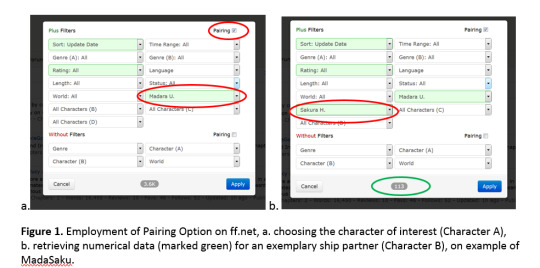
Data gathered through browsing through all of the Naruto characters with Pairing Option On give unequivocal results. The only limitations of this method is the relatively late introduction time point of Pairing Option (introduced in 2013, while Naruto started publishing in 1999), and sometimes peculiar definitions of “Characters” on ff.net (example: Naruko as a separate character, “Team 7” as a “Character”).
Results for Madara and Sakura are presented below (Figures 2. and 3.) For clarity, ships with four or more fics are shown for Madara. In case of Sakura, all the ships with >4 fics in a graph would blur the picture. Therefore, her Top 20 ships are presented in Figure 3., and the rest is summarized in the Table 1. The analysis was performed on 22.10.2019.


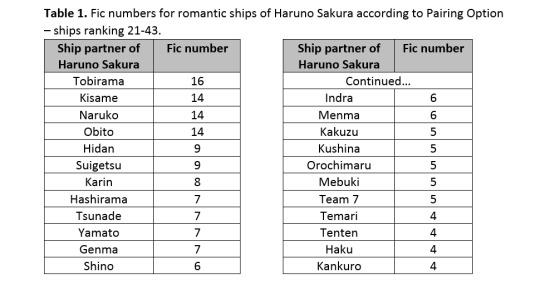
However, ff.net was launched on 15.10.1998 (which precedes publication of Naruto by one year) so there is a 14 year-worth of fic creation when the Pairing Option wasn’t available. To get the complete overview of ship popularity it is necessary to include the body of work created in the earlier years of ff.net.
This issue was addressed through Approach 2.
Approach 2
During the period of 1998-2013 fics were labelled with ship names in the summaries, and readers would look for ships of interest typing ship name into the search box. During those times certain conventional phrases were coined for the ships, and putting those in the summary allowed potential readers to find the story. Searching ff.net using selected phrases and collecting the corresponding fic numbers gives insight into those part of fanworks. Employment of search engine is shown in Figure 4. on the example of phrase “madasaku”.

I performed searches for common ships, basing the list on the ships with 4 or more fics as found using Pairing Option (see: section above).
I searched for the phrases that were and still are still commonly used ship names in Naruto fandom.
In general, there are three common ways to indicate a ship:
a) Merger of names, usually using first two syllables of both names, usually (but not always) with male name being first part of the phrase. Example: madasaku, and (less commonly used) sakumada. For the M/M and F/F couples, both orders are used, and it is impossible to predict which form is more common. Example: sakuhina and hinasaku would be used with similar frequency. In case of names composed of two syllables or shorter, one syllable is often used.
b) Name_1xName_2 – complete names of characters separated by letter “x”, without spaces in between. There is no strict preference as to which name goes first more frequently, i.e. sakuraxmadara is equally plausible as madaraxsakura.
The same naming scheme exists also in a version with spaces (example: Madara x Sakura). Searching for such phrases (and all phrases including spaces) required putting the Ship Name between quotation marks (”Madara x Sakura”).
c) A combination of the above, i.e. shortened versions of names connected with an “x”; with spaces (example: mada x saku) and without spaces (madaxsaku - again searched using apostrophes)
Search engine of ff.net is case-insensitive, i.e. searching for “madasaku” will bring the same results as searching for “Madasaku” and “MadaSaku” (thank gods).
Naming convention that is common on AO3, i.e. separating character names with slash “/”, isn’t correctly recognized by search engine. If the phrase is written without usage of spaces (example: Madara/Sakura) the search results in list of fics containing “Madara” and “Sakura”, not necessary together (slash symbol gets ignored). When phrase “Madara/Sakura” is searched with quotation marks, slash still gets ignored and results include all entries with any symbol between the names. Therefore, the ship names weren’t included in this analysis.
Other potential ship names variations (using “*”, using “&”, and surely a multitude of others variants that I couldn’t think of) were not included due to their relative infrequency (and limits to my capacity and imagination).
For every ship included in the results of Approach 1 (total 43 searches for Sakura’s ships, and 12 searches for Madara’s ships), I searched for the following phrases (on example of MadaSaku ship):
madasaku
sakumada
madaraxsakura
sakuraxmadara
madaxsaku
sakuxmada
madara x sakura
sakura x madara
mada x saku
saku x mada
Certain ship names don’t follow the usual rules and/or required special treatment. For example, for the ship Gaara/Haruno Sakura the common name merger is GaaSaku (and not GaaraSaku). Tsunade/ Haruno Sakura is equally often (or rarely, because it is very rare) abbreviated to TsuSaku and Tsunasaku. Fics tagged with TobiSaku name merger may mean Senju Tobirama/Haruno Sakura as well as Tobi (Obito’s persona)/Haruno Sakura – in this case, fics were manually inspected, and assigned to correct categories. Ship with Naruko (which scored relatively high in Pairing Option analysis), was not possible to correctly assess, because the merger name “narusaku” is identical for the merger of Uzumaki Naruto/Haruno Sakura (for good reasons).
All the fics for given pair were summed up (i.e. for Uchiha Madara/Haruno Sakura ship the fic numbers retrieved through searches for “madasaku”, “sakumada”, “madaraxsakura”, “sakuraxmadara”, “madaxsaku”, “sakuxmada” “madara x sakura”, “sakura x madara”, “mada x saku” and “saku x mada” were added together). The obtained results will be referred to as those of “Ship Name” in this analysis.
Results for Madara and Sakura are presented below (Figures 5. and 6.). In case of Sakura, including all the examined ships in a graph would blur the picture. Therefore, her Top 20 ships are presented in Figure 6., and the rest is summarized in the Table 2. The analysis was performed on 22.10.2019. The additionally searches performed on 31.12.2019 did not take under consideration fics published after 22.10.2019, to reflect the state of fandom on the day of main analysis.
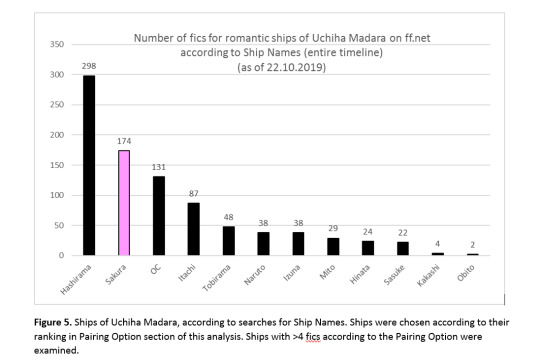

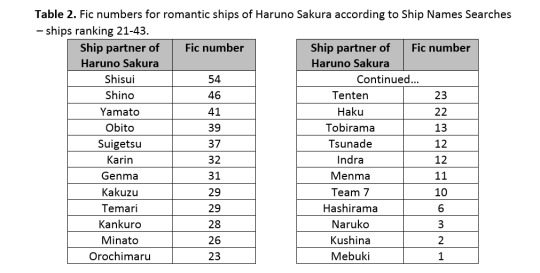
This list presented in Table 2 is not a comprehensive one. There are certainly more ships with >10 fics that were not included. One prominent, detected example is Chōji, who has 13 fics in as a ship partner of Sakura, but was not included in Table 2 because according to the Pairing Option he had no fics with Sakura.
Limitations of the method
Employed method depends on performing six independent searches and summing up the numbers from those searches. A fic tagged with more than one of the searched phrases will be counted multiple times. For example: if a fic contained phrases “MadaSaku” and “MadaraxSakura” in its summary, it was counted twice. In extreme case, one fic would generate ten data points: one real, and nine false.
Nevertheless, since the same treatment was applied to all the pairings, the errors should be distributed in the same way across all the ships. Therefore, even if the numerical values obtained through this analysis don’t necessarily correspond to reality, the results should reflect respective relations between the ships (i.e. “ranking” should be correct). This assumption is true however only if all the subdivisions of the fandom follow the same customs and tagging etiquette. I.e. if creators writing for SasuSaku followed a habit of including only one Ship Name in their summaries, while creators of MadaSaku tended to include multiple Ship Names, then my method of analysis would overestimate the significance of MadaSaku ship. However, I am not aware about such trends existing in Naruto fandom.
Additionally, Ship Name tagging system allows for tagging infinite number of ships in one fic, therefore certain fics have been counted multiple times.
Discussion
When considering fics tagged with Pairing Option, Sakura ranks as Madara’s second most popular ship partner, after Hashirama and before Tobirama. As on AO3, it is telling that a relatively “exotic” pairing with OC ranks 4th among Madara’s ships.
Madara is the 9th most popular ship partner of Sakura. Comparing and contrasting Sakura’s data between ff.net and AO3 would be an interesting analysis in its own right, but here I will only point out the switch of positions between Naruto and Kakashi as Sakura’s ship partners (Naruto is a strong 2nd on ff.net, while Kakashi takes this position on AO3); and relatively low, 7th place of Ino (strong 4th on AO3).
When taking into account data gathered though Ship Names Searches, Sakura ranks as Madara’s 2nd most popular ship partner (after Hashirama and before OC).
Madara, on the other hand is Sakura’s 15th most popular ship partner. Since Ship Names Searches results are mostly derived from fics published in earlier years in Naruto fandom, his lower place can be explained by his very late appearance in the franchise (on-panel in February 2008 - almost 9 years after Naruto started publishing and in person in the story in October 2011 - 12 years after begin of publishing).
Data gathered in this analysis present a unique opportunity for looking into the development of ship popularity over time.
Results from Pairing Option reflect mostly the state of fandom in years 2013-2019, while the results from Ship Names Search show the status from the earlier years. The exact division is however somewhat blurred as some fics published before October 2013 has been retroactively tagged using Pairing Option (even if the majority of older fics remain untagged). The reverse is also true – many fics published after introduction of Pairing Option, even as recently as end of 2019, fail to use it. Additionally, many fics are tagged using both systems: the Pairing Option and Ship Name in summary.
Nevertheless one can tentatively regard Pairing Option results as “new”, or “current” ones, while the ones coming from the Ship Names Searches as “older” ones.
Figure 7. presents position changes in Top 12 Madara’s ships. Ranking from Pairing Option analysis was regarded as current and compared to the “older” ranking composed from all the fics tagged with Ship Names (regardless their publishing date). A positive value in the Figure 7. indicates a gain of popularity, for example: Tobirama gained 2 positions among Madara’s ships when comparing the “current” and “older” results.
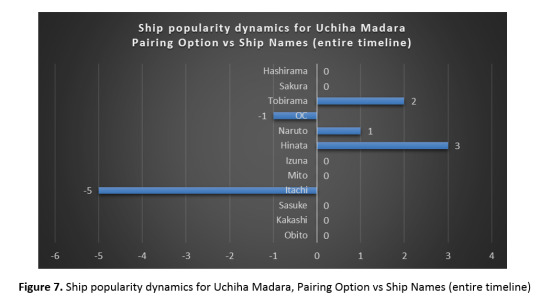
This analysis reveals that certain ships (with Tobirama, Naruto and Hinata) gained, while ships with OC and Itachi lost on popularity. Dramatic loss of Itachi ship popularity is very interesting and one can speculated that it could be caused by Tobi/Obito reveal.
The same analysis was performed for Sakura’s ships and is presented in Figure 8.

Inspecting changes in Sakura ships’ rankings allows for several interesting observations. Minato, Shisui, Madara and Sasori are among greater winners. It is symptomatic that all, except Sasori, are characters that appeared (or became relevant) later during the franchise. Among the characters losing in popularity as Sakura’s ship partners are members of Konoha Eleven (Lee, Kiba, Sai, Neji), an Akatsuki member (Deidara) and OC. It should also be noted that five top positions (Sasuke, Naruto, Kakashi, Itachi and Gaara) remained unchanged.
To further examine the “current” and “older” state of fandom, upon harvesting Ship Names data I sorted the fics according to publication date and took note of how many fics were published before and how many after 01.10.2013 (approximate date of introduction of Pairing Option tool).
If one repeats the analysis from Figures 7. and 8. considering only fics published before 01.10.2013 as “older” ones, the following pictures appears (Figure 9. and 10.):

Using this definition of “older” fics (i.e. fics tagged with Ship Names that were published until October 2013), the gain of popularity of Tobirama ship becomes even more evident (gain of 7 positions). Ships with Itachi (as in the previous analysis) and Sasuke (undetected in the previous analysis) lost on popularity.

Sakura ships’ dynamics according to this definition of “older” fics show even more pronounced positions’ gains of Minato and Shisui, but otherwise similar trends to previous analysis.
Analysis of ship popularity on ff.net is a challenging one, but since this platform was, and still is main archive for Naruto fandom (407 thousands fics vs 49 thousand on AO3) it is important to address this issue even if methodology is far from perfect.
I am open to all the comments, suggestions and hints, as the data collection was a major effort and I’m sure that this data can be used in many other different ways.
And, your feedback showed me that people are interested in such stuff. Thank you for this!!! I have at least three further ideas for analysis, and now, when I have some experience and first insight into data, it will be easier.
35 notes
·
View notes
Photo

For the week of 23 April 2018
Quick Bits:
Abbott #4 gives us the penultimate issue to the series, dropping all the pieces together to put Abbott on the path to discovery what is going on with all the death and paranormal stuff. The layouts from Sami Kavelä just elevates the storytelling to the next level.
| Published by BOOM! Studios

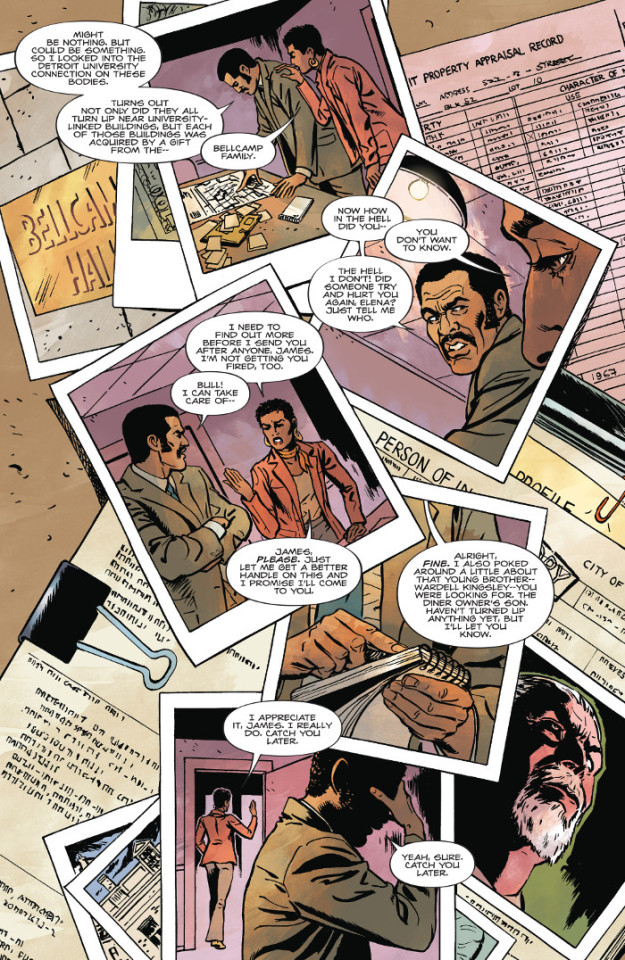

Aliens: Dust to Dust #1 is a fairly visceral beginning to this new min-series written and illustrated by Gabriel Hardman (with colours from Rain Beredo). It starts in terror as Maxon begins seeing violence outside his window and finds a facehugger attached to his mother, and just explodes from there with the colony world of LV-871 overrun by xenomorphs.
| Published by Dark Horse



Avengers #690 brings both “No Surrender” and this volume of Avengers to an end, serving as a coda to the series, tying up some loose ends, saying some goodbyes--especially as many of the X-Men characters seem to be going back home--and setting up some of the things to come. This has been a great story, with some wonderful art along the way, that well-encapsulated this era of the Avengers while presenting a fairly widescreen epic.
| Published by Marvel



Big Trouble in Little China: Old Man Jack #8 is the big confrontation with Ching Dai and it’s...not what you’d expect. Great art as usual from Jorge Corona.
| Published by BOOM! Studio



Bloodborne #3 is filled will existential dread. Particularly with the idea of that unknown, unseen terror hanging above your head, waiting to pounce. And of monsters being everywhere.
| Published by Titan



Cyber Force #2 continues the slow burn rebuilding and reintroduction of the team and their antagonists, with this issue mainly focusing on Velocity discovering the extent of her powers and revealing the updated version of Killjoy. Like the first issue, much of the story is similar, but the details get fleshed out a bit more and the look of the characters tends to be a bit different. It does highlight the differences in comics storytelling between today and twenty-five years ago. What used to be told in a handful of panels or a throwaway line now takes half an issue.
| Published by Image / Top Cow



Deep Roots #1 is another stellar debut from Vault, with absolutely gorgeous artwork from Val Rodrigues and Triona Farrell. The story...is a bit Swamp Thing-y, but not. It’s strange. Dan Watters excels at strange.
| Published by Vault

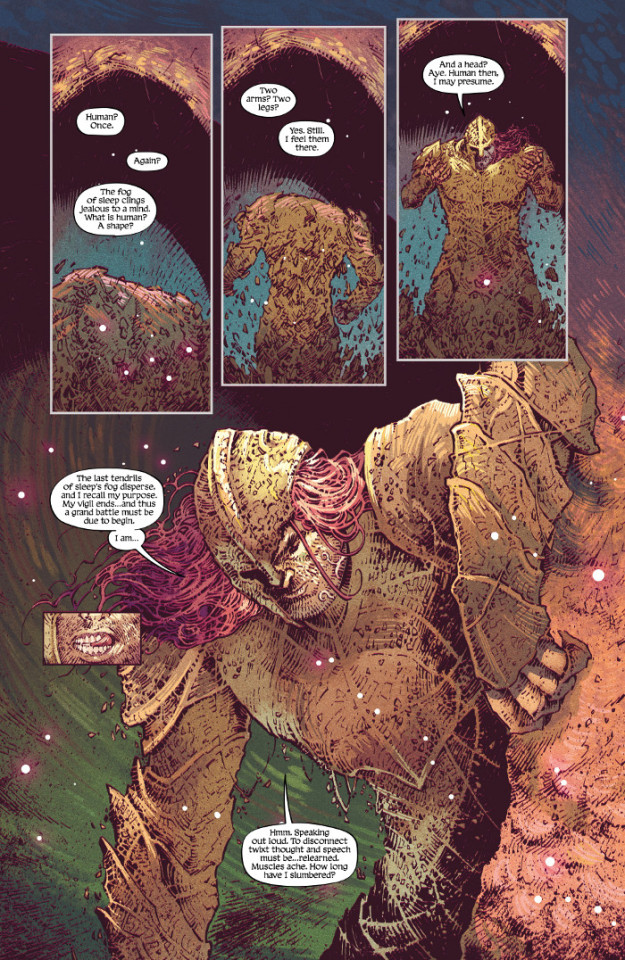

Doctor Strange #389 continues this necessary chunk of the “Damnation” event, revealing how Strange exited the depths of hell in order to get back to Las Vegas. Its structure is a bit odd, given that it’s actually told as a flashback, breaking with how the arc has been presented up until now, and it skips over what actually happens in Damnation #4, but it’s still entertaining. Donny Cates adds quite a few bits of reactive humour and the art from Niko Henrichon continues to be astounding.
| Published by Marvel

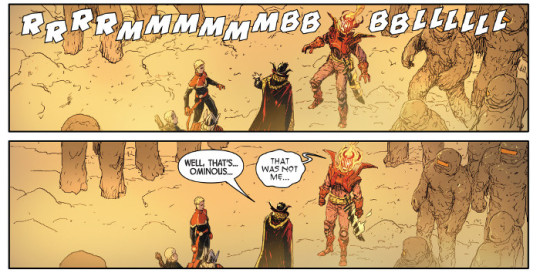

Doctor Strange: Damnation #4 concludes the event. I’ve enjoyed it overall, with some great moments spread across the constituent parts, but the main series itself has been told in a fairly oblique manner, leaving important details up to the tie-ins of Doctor Strange and Johnny Blaze. I don’t mind, personally, but if you’re only reading Damnation, it would feel a bit choppy. I am hoping that the tease of more Midnight Sons bears fruit. Some great art again from both Rod Reis and Szymon Kudranski.
| Published by Marvel



Dungeons & Dragons: Evil at Baldur’s Gate #1 returns the adventuring party home and has them scatter almost immediately, leaving Minsc and Boo to find their own misadventure about the city. Being Minsc and Boo-centric, Jim Zub opts for a story that’s a little sillier than usual, but it’s very welcome.
| Published by IDW



Exiles #2 is a rather fun comic, finishing up the gathering of the team, as they hop from realities under threat from the desiccated corpse version of Galactus that is the Time Eater. The differing realities that Saladin Ahmed is playing with here transcends earlier versions with the inclusion of Wolvie, allowing for a radically different interpretation and style of comics not often included in these kinds of reality hopping stories. It gives a nice bit of comic relief and allows Javier Rodríguez to further flex his artistic muscle. Between stylistic changes, layouts, and panel transitions, this is a damn good looking comic. Rodríguez, Álvaro López, and Chris O’Halloran are making the art as adventurous as the story.
| Published by Marvel

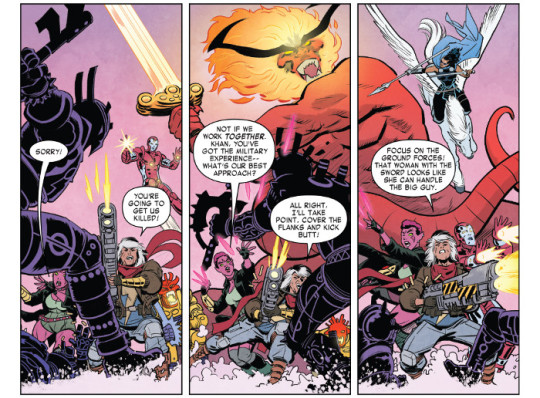

Gasolina #7 returns with Amalia and Randy hiding out and playing house with Amalia’s nephew, who is still somehow alive with one of those alien bug things in him. It’s still kind of weird how Sean Mackiewicz is presenting this mix of oddities with a more standard crime narrative, where the aliens/whatever-they-are are just about the least important thing. It’s a nice approach, drawing out the more “normal” aspects comparatively.
| Published by Image / Skybound

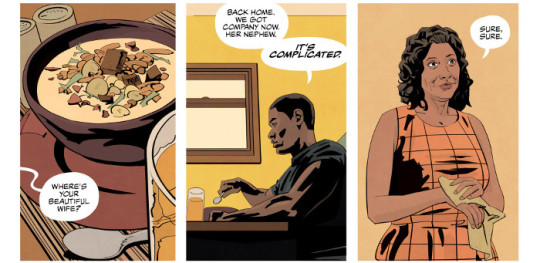

Grass Kings #14 drops one hell of a bombshell in this penultimate issue. Matt Kindt, Tyler & Hilary Jenkins are ensuring that this series goes out on a high note.
| Published by BOOM! Studios

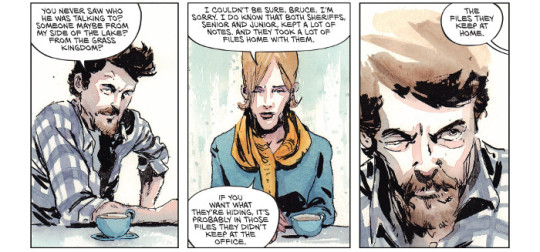

Hunt for Wolverine #1 is a pretty good start to this event, even if ultimately the premise of Wolverine missing--when he’s been hopping around the Marvel Universe just missing anyone--is a little ridiculous. I mean, if he still has an Infinity Stone, despite the recent flowchart in Infinity Countdown #2, it makes a bit of sense, but otherwise... Anyway, Charles Soule, David Marquez, and Rachelle Rosenberg put together a great lead story, setting up the mystery of Logan’s missing body, and it remains to be seen how and why he actually came back. The second story, from Soule, Paulo Siquiera, Walden Wong, and Ruth Redmond then essentially sets up the spin-off series with the different teams looking for Wolverine.
| Published by Marvel



Ice Cream Man #4 serves up another cone of seriously strange horror. Like if you made beer-flavoured ice cream and topped it with bits of chocolate-covered grasshopper. This one features an outing between an estranged friend and the friend’s deadbeat dad after his funeral and it just gets more bizarre from there.
| Published by Image



Jeepers Creepers #1 is not something I ever expected to see. Although the first two movies were relatively successful, at the very least as cult horror flicks, I would have thought the surprisingly released third film and Victor Salva’s reputation killed the chance of this as a viable property that anyone would want to associate with. But here we are. In any event, Marc Andreyko pens an interesting story. Aside from the nods to the films like the Creeper’s truck, we mainly follow a grad student as he searches for connections between the Creeper and Aztec mythology. Not a bad premise, even if it feels like it’s coming from left field. The art from Kewber Baal, with colours by Jorge Sutil, is also pretty nice.
| Published by Dynamite



Kill or Be Killed #18 takes a bit of a sidestep as we head toward the series’ conclusion. I love when Ed Brubaker starts laying out the steps in a crime, or in a case as it were, and this issue follows the task force assigned to solving Dylan’s murders, especially in the wake of the death of the copycat they closed the case with. It’s interesting how the clues are presented and followed and as usual Sean Phillips and Elizabeth Breitweiser make it look gorgeous.
| Published by Image



KINO #5 begins the second arc, changing tone a bit as the series takes a darker turn with ChrisCross taking over the art duties here. Gone are the throwback styles of old comics and now we’ve got some stranger things as Alistair Meath has realized that he’s in some sort of simulation or...something. It’s an interesting shift, even with the introduction of Meath’s family in the real world, as the series seems to take on a more realistic, and slightly darker, tone, even though the real world sequences aren’t much different from what Joe Casey wrote in the previous issues.
| Published by Lion Forge / Catalyst Prime



The Mighty Thor #706 is a beautiful farewell to the Lady Thor, with some drop dead gorgeous artwork from Russell Dauterman and Matthew Wilson. This is a wonderful capstone to Jason Aaron and Dauterman’s run with Jane Foster and it will be interesting to see where Aaron goes next with the continuing war of the realms and the return of Thor Thor.
| Published by Marvel



Moon Knight #194 features some really nice guest art from Ty Templeton as Max Bemis pens a tale about a particularly dark period of Marc’s childhood. It’s a good single issue story dealing with some very heavy subject matter.
| Published by Marvel



Pathfinder: Spiral of Bones #2 features some really nice art from Tom Garcia and Morgan Hickman, as the story shifts to Valeros’ predicament of being dead and being mistaken for a particularly nasty individual. I enjoy how Crystal Frasier is expanding upon the Pathfinder concepts for the afterlife and Valeros’ situation is fairly funny, even if dire.
| Published by Dynamite



Sacred Creatures #6 was worth the wait. I know this series doesn’t get a lot of press, and often slips its schedule, but what Pablo Raimondi and Klaus Janson are crafting here is some pretty heady stuff, with reinterpretations of biblical epics and an entirely different take on the Nephilim and the Seven Deadly Sins (of which we learn there was an eighth this issue, Vanity, although vanity is usually just an example of pride). It’s good, it’s dense, and it’s beautifully illustrated.
| Published by Image



Strangers in Paradise XXV #3 keeps Katchoo on the path to find Stephanie Kelly. I love Terry Moore’s humour and this issue has it in spades.
| Published by Abstract Studio



Thanos Annual #1 is a collection of mostly dark humour stories of Thanos as told by a motley crew of creators, including the recently departed Thanos creative team of Donny Cates and Geoff Shaw, and a number of other luminaries like Al Ewing, Chris Hastings, Frazer Irving, Katie Cook, Kieron Gillen, and more. It’s a fun set of stories, also serving as a bit of bridge to the forthcoming Cosmic Ghost Rider mini-series.
| Published by Marvel



Witchblade #5 goes deeper in the darkness that has rooted itself deep within New York City’s underworld as Alex investigates a dirty cop, unveiling a web of corruption. We also get a really nice reveal at the end of the issue.
| Published by Image / Top Cow



X-Men Blue #26 unleashes more of Miss Sinister’s Mothervine plan across the world with secondary and tertiary mutations occurring, along with old depowered X-Men regaining powers. This feels bigger than something that’s just confined to one X-book, which is a testament to the level of storytelling Cullen Bunn is bringing here. While there are timeline quibbles, especially with Venomized going on currently that has already brought the original five back to Earth, it is entertaining to see Polaris’ new team in action.
| Published by Marvel



X-O Manowar #14 is one of the most beautiful and heartbreaking things you can read this week. Matt Kindt, Ariel Olivetti, and Dave Sharpe return Aric to Earth, but not to home.
| Published by Valiant



Other Highlights: All-New Wolverine #34, Archie #30, Babyteeth #10, The Beef #3, Black AF: Widows & Orphans #1, Crossroad Blues, Cult Classic: Return to Whisper #2, Days of Hate #4, The Despicable Deadpool #299, Factory #2, Giles #3, Harrow County #30, Hillbilly #9, Hit-Girl #3, Incidentals #8, Invincible Iron Man #599, Jim Henson’s Labyrinth: Coronation #3, Legion #4, Lockjaw #3, Lumberjanes #49, Mighty Morphin Power Rangers Annual 2018, Now #3, Old Man Hawkeye #4, The Pervert, Peter Parker: The Spectacular Spider-Man #303, The Prisoner #1, Reactor #3, Redneck #12, Regression #9, Rick & Morty #37, Saga #51, Shadowman #2, Sheena: Queen of the Jungle #8, Songs for the Dead #2, Spider-Gwen #31, Star Wars: Darth Vader #15, Star Wars: Doctor Aphra #19, Throwaways #13, Venom #165, Venomized #4, The Wilds #2
Recommended Collections: The Damned - Volume 2: Ill Gotten, Dead of Winter: Good Good Dog, Fear Agent: Final Edition - Volume 1, Goldie Vance - Volume 4, Hack/Slash: Resurrection - Volume 1, Heavy Vinyl, Jessica Jones - Volume 3: Return of the Purple Man, KINO - Volume 1: Escape from the Abyss, Lazarus Sourcebook Collection - Volume 1, Mighty Morphin Power Rangers - Volume 5, Spirits of Vengeance: War at the Gates of Hell, Star Wars: Darth Vader - Volume 2: Legacy’s End, Stumptown - Volume 2: The Case of the Baby in the Velvet Case

d. emerson eddy wonders.
0 notes